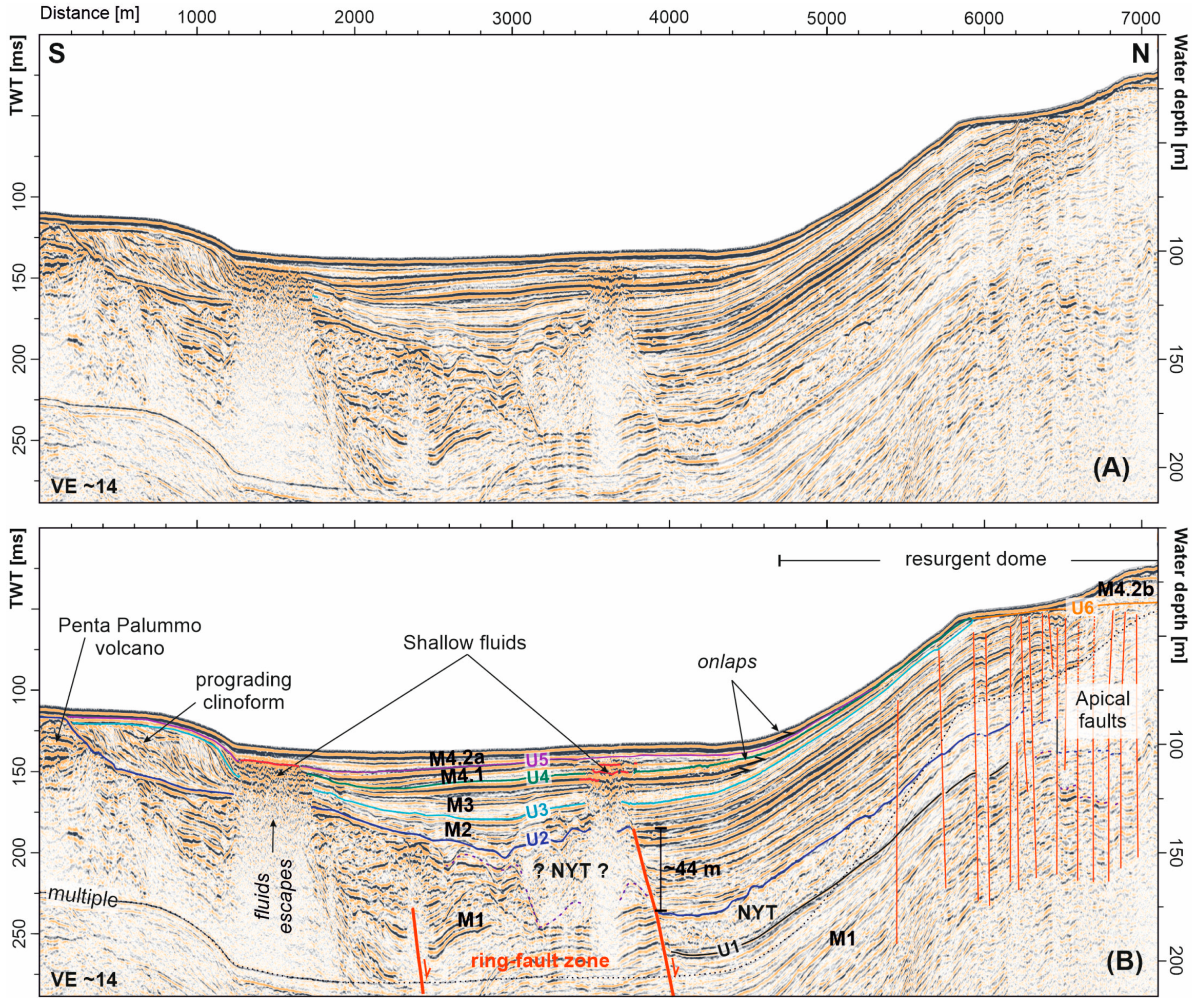Integrated Morpho-Bathymetric, Seismic-Stratigraphic, and Sedimentological Data on the Dohrn Canyon (Naples Bay, Southern Tyrrhenian Sea): Relationships with Volcanism and Tectonics
Abstract
1. Introduction
2. Material and Methods
3. Geological Setting
4. Results
4.1. Morpho-Bathymetry and Gravity Instabilities of the Naples Bay Canyons
4.1.1. Geomorphologic Map of Naples Canyons
4.1.2. Bathymetric Profiles
4.2. Main Seismic Facies Recognized on Subbottom Chirp Profiles
4.2.1. Channel-Levee Complex
4.2.2. Gravity Flow Deposits
4.3. Seismic Stratigraphy
4.4. Sedimentological and Petrophysical Data
4.4.1. Sedimentological Data
- -
- Facies A (720–530 cm)—From base to top, it consists of semi-consolidated, silty sand including lens of small, mostly rounded pumice and bioclasts with evidence of reworking. At 625 cm, a decimeter thick level of fining upward medium coarse sand, with an erosive base, consisting mainly of volcaniclasts (scoriae, minerals, and glass shards);
- -
- Facies B (530–240 cm)—It consists of clayey silt with bioclasts (planktonic and benthonic foraminifera) interbedded with decimetric to centimetric layers and lenses of parallel and cross laminated, medium and fine sandy silt, often with erosive base and normal grading. The coarser fraction is mostly represented by gray pumice, scoriae, glass shard, well preserved minerals (e.g., sanidine, peroxide, biotite). At a depth of 530 cm, a 55 cm-thick layer of coarse pumice with sub-angular to sub-rounded clasts occurs with reverse grading (e10). Coarse-grained components of these deposits are formed by moderately sorted, sub-angular volcaniclastic fragments (pumice, scoria, K-feldspar, pyroxene, volcanic glass). These deposits pass upward to 30 cm of silty sandy pumice with rare shallow water faunas (benthic foramifers, shell fragments). At a depth of 425 cm follows a 20 cm-thick layer, with erosional base, including sub-angular to sub-rounded pumice and occasional iron-oxidized patinas, rare pelitic pebble, and reworked fragments of Mollusk shells (e9). Toward the top follow centimetric lenses (403 cm, 378 cm, 252 cm, and 249 cm) and fining upward and/or parallel and crossed laminated decimetric levels (438 cm, 300 cm) of volcaniclasts, (e4–e8);
- -
- Facies C (240–0 cm)—It is composed of homogeneous grey mud, represented by bioturbated clayey silt and clayey sandy silt with a few interbedded layers rich in volcaniclasts (170–160 cm, 160–153 cm, 43–37 cm) (e1–e3) and/or bioclasts (153–135 cm, 60–50 cm).
4.4.2. Physical Properties and Stratigraphic Correlation
5. Discussion
- -
- Stage 1 (15 ka) During stage 1 the sea level stationed at ca. −93 m below the present-day level and the main volcano-tectonic event was represented by the caldera collapse related to the NYT eruption (Figure 23 and Figure 24). The central part of the NYT caldera collapse was in the submarine domain, whereas outside of the caldera depression, subaerial conditions prevailed in the coastal area. Unconformity U2 correlates with the top of the NYT deposits and represents a partly submarine and partly subaerial feature. This unconformity also marks a channel-like topographic low, genetically related with the erosional truncation of the M1 seismic sequence (Figure 24), corresponding to the actual location of the Dohrn Canyon and its continuation toward the north-west. The Miseno bank was partly emerged, and formed a peninsula connected to the mainland, whereas the Pentapalummo bank was an island in northern Naples Bay. During this stage, the Dohrn canyon extended toward the north-west and drained significant amounts of volcaniclastic materials originated during the NYT eruption toward the outer shelf and slope.
- -
- Stage 2 (15.0–8.6 ka) During stage 2, the sea level rose to ca. 19 m below the present-day level. causing a generalized backstepping of depositional systems and the flooding of the Miseno and Pentapalummo banks. During this period (10.3–9.5 ka) the tuff cone of Nisida Bank, was formed. At the Dohrn canyon head, the onset of this tuff cone had the effect of hampering the down-canyon removal of volcaniclastic deposits, which resulted in turn in a rapid infilling of the abandoned section of the canyon (DC = Dohrn canyon fill). During the sea level rise prograding clinoforms developed on the flanks of the bathymetric highs of the Miseno and Pentapalummo banks.
- -
- Stage 3 (8.6–5.0 ka) During stage 3, the sea level rose from ca. 19 m to 4 m below the present-day level (Figure 23 and Figure 24) and at least six magmatic to phreato-magmatic eruptions occurred. The sea level rise resulted in additional landward retreat of the shoreline outside of the NYT caldera structure. Early during this stage the La Starza terrace (Pozzuoli Bay) progressively emerged due to the ground uplift associated with the NYT caldera resurgence and, at same time, marine unconformities U3 and U4 formed as a response to the consequent decrease in the accommodation space over the continental shelf (Figure 23 and Figure 24).
- -
- Stage 4 (5.0–2.0 ka) Stage 4 represents a period of minor sea level rise, from 4 m to 1 m below the present-day sea level, that was accompanied by a further backstepping of depositional systems and landward shift of the shoreline. At the time of the eruptions of Capo Miseno (3.7 ka B.P.) and Nisida Island (3.98 ka B.P.), sea level was 2.5–2.7 m below the present-day level. The deposits of both these eruptions are found, as reworked marine tephra layers in the stratigraphic record of the Pozzuoli Bay and can be used as chronostratigraphic markers. Marine unconformity U5 marks the end of the uplift phase associated with last major eruptions occurred in the marine area of the Campi Flegrei and postdates the tephra layers resulted from the events of Capo Miseno and Nisida Island (Figure 23 and Figure 24).
- -
- Stage 5 (2.0 ka–present) During stage 5, the sea level slightly continued to rise from ca. –1 m to the present the present-day level (Figure 23 and Figure 24). Since the beginning of this stage a significant phase of subsidence, affected the inner sector of the Pozzuoli Bay as testified by dramatic drowning of coastal settlements and infrastructures of Roman age. Subsidence in the range of 20 m to 8 m, with average rates of 10–4 mm/year also led to the drowning of the coastal shallow-water terrace associated with unconformity U6 and related prograding clinoforms. This created significant accommodation space, resulting in the deposition of the present day coastal prograding wedge (Figure 23).
6. Conclusions
Author Contributions
Funding
Acknowledgments
Conflicts of Interest
References
- Fabbri, A.; Gallignani, P.; Zitellini, N. Geologic evolution of the peri-Tyrrhenian sedimentary basins. In Sedimentary Basins of Mediterranean Margins, 1st ed.; Wezel, F.C., Ed.; Tecnoprint: Bologna, Italy, 1981; pp. 101–127. [Google Scholar]
- Malinverno, A.; Ryan, W.B.F. Extension in the Tyrrhenian sea and shortening in the Apennines as a result of arc migration driven by sinking of the lithosphere. Tectonics 1986, 5, 227–245. [Google Scholar] [CrossRef]
- Trincardi, F.; Zitellini, N. The rifting of the Tyrrhenian basin. Geomarine Lett. 1987, 7, 1–6. [Google Scholar] [CrossRef]
- Oldow, J.S.; D’Argenio, B.; Ferranti, L.; Pappone, G.; Marsella, E.; Sacchi, M. Large-Scale longitudinal extension in the southern Apennines contractional belt. Geology 1993, 21, 1123–1126. [Google Scholar] [CrossRef]
- Shackleton, N.J.; Opdyke, N.D. Oxygen isotope and palaeomagnetic stratigraphy of equatorial Pacific core V28-238: Oxygen isotope temperatures and ice volume on a 105 and 106 year scale. Quat. Res. 1973, 3, 39–55. [Google Scholar] [CrossRef]
- Fairbanks, R.G.; Matthews, R.K. The marine oxygen isotope record in Pleistocene coral, Barbados, West Indies. Quat. Res. 1978, 10, 181–196. [Google Scholar] [CrossRef]
- Chappell, J.; Shackleton, N.J. Oxygen isotopes and sea level. Nature 1986, 324, 137–140. [Google Scholar] [CrossRef]
- Martinson, D.G.; Pisias, N.G.; Hays, J.D.; Imbrie, J.S.; Moore, T.C.; Schackleton, N.J. Age Dating and the Orbital Theory of the Ice Ages: Development of a High Resolution 0 to 300,000 year chronostratigraphy. Quat. Res. 1987, 27, 1–29. [Google Scholar] [CrossRef]
- Bard, E.; Hamelin, B.; Fairbanks, R.G. U-Th ages obtained by mass spectrometry in corals from Barbados: Sea level during the past 130,000 years. Nature 1990, 346, 456–458. [Google Scholar] [CrossRef]
- Pirazzoli, P.A. Global sea-level changes and their measurements. Glob. Planet. Chang. 1993, 8, 135–148. [Google Scholar] [CrossRef]
- Lambeck, K.; Chappell, J. Sea level change through the Last glacial cycle. Science 2001, 292, 679–686. [Google Scholar] [CrossRef]
- Mastronuzzi, G.; Sansò, P.; Murray-Wallace, C.V.; Shennan, I. Quaternary coastal morphology and sea level changes—An introduction. Quat. Sci. Rev. 2005, 21, 283–293. [Google Scholar] [CrossRef]
- Caputo, R. Sea-level curves: Perplexities of an end-user in morphotectonic applications. Glob. Planet. Chang. 2007, 57, 417–423. [Google Scholar] [CrossRef]
- Gamberi, F.; Marani, M. Deep-sea depositional systems of the Tyrrhenian basin. Mem. Descr Carta Geol. d’Ital. 2004, 54, 127–146. [Google Scholar]
- Cosentino, D.; De Rita, D.; Funiciello, R.; Parotto, M.; Salvini, F.; Vittori, E. Fracture System in Phlegrean Fields (Naples, Southern Italy). Bull. Volcanol. 1984, 47, 247–257. [Google Scholar] [CrossRef]
- Di Girolamo, P.; Ghiara, M.R.; Lirer, L.; Munno, R.; Rolandi, G.; Stanzione, D. Vulcanologia e petrologia dei Campi Flegrei. Boll. Della Soc. Geol. Ital. 1984, 103, 349–413. [Google Scholar]
- Cinque, A.; Rolandi, G.; Zamparelli, V. L’estensione dei depositi marini olocenici nei Campi Flegrei in relazione alla vulcano tettonica. Boll. Della Soc. Geol. Ital. 1985, 104, 327–348. [Google Scholar]
- Rosi, M.; Sbrana, A. Phlegrean Fields; Quaderni De La Ricerca Scientifica, Consiglio Nazionale delle Ricerche: Roma, Italy, 1987; Volume 114, pp. 1–175. [Google Scholar]
- Scandone, R.; Bellucci, F.; Lirer, L.; Rolandi, G. The structure of the Campanian Plain and the activity of the Neapolitan Volcanoes (Italy). J. Volcanol. Geotherm. Res. 1991, 48, 1–31. [Google Scholar] [CrossRef]
- Orsi, G.; De Vita, S.; Di Vito, M.A. The restless, resurgent Campi Flegrei nested caldera (Italy): Constraints on its evolution and its configuration. J. Volcanol. Geotherm. Res. 1996, 74, 179–214. [Google Scholar] [CrossRef]
- Di Vito, M.A.; Isaia, R.; Orsi, G.; Southon, J.; De Vita, S.; D’Antonio, M.; Pappalardo, L.; Piochi, M. Volcanic and deformational history of the Campi Flegrei caldera in the past 12 ka. J. Volcanol. Geotherm. Res. 1999, 91, 221–246. [Google Scholar] [CrossRef]
- Perrotta, A.; Scarpati, C.; Luongo, G.; Morra, V. The Campi Flegrei caldera boundary in the city of Naples. In Volcanism in the Campania Plain: Vesuvius, Campi Flegrei and Ignimbrites, 1st ed.; De Vivo, B., Ed.; Elsevier Science Publishers: Amsterdam, The Netherlands, 2006; pp. 85–96. [Google Scholar]
- Acocella, V.; Funiciello, R.; Marotta, E.; Orsi, G.; De Vita, S. The role of extensional structures on experimental calderas and resurgence. J. Volcanol. Geotherm. Res. 2004, 129, 199–217. [Google Scholar] [CrossRef]
- Acocella, V. Activating and reactivating pairs of nested collapses during caldera forming eruptions: Campi Flegrei, Italy. Geophys. Res. Lett. 2008, 35, L17304. [Google Scholar] [CrossRef]
- Acocella, V. Evaluating fracture patterns within a resurgent caldera: Campi Flegrei, Italy. Bull. Volcanol. 2010, 72, 623–638. [Google Scholar] [CrossRef]
- Costa, A.; Folch, A.; Macedonio, G.; Giaccio, B.; Isaia, R.; Smith, V.C. Quantifying volcanic ash dispersal and impact of the Campanian Ignimbrite super-eruption. Geophys. Res. Lett. 2012, 39. [Google Scholar] [CrossRef]
- Capuano, P.; Russo, G.; Civetta, L.; Orsi, G.; D’Antonio, M.; Moretti, R. The active portion of the Campi Flegrei caldera structure imaged by 3-D inversion of gravity data. Geochem. Geophys. Geosyst. 2013, 14. [Google Scholar] [CrossRef]
- Sacchi, M.; Pepe, F.; Corradino, M.; Insinga, D.D.; Molisso, F.; Lubritto, C. The Neapolitan Yellow Tuff caldera offshore the Campi Flegrei: Stratal architecture and kinematic reconstruction during the last 15 ky. Mar. Geol. 2014, 354, 15–33. [Google Scholar] [CrossRef]
- Vitale, S.; Isaia, R. Fractures and faults in volcanic rocks (Campi Flegrei, Southern Italy): Insight into volcano-tectonic processes. Int. J. Earth Sci. 2014, 103, 801–819. [Google Scholar] [CrossRef]
- Aiello, G.; Marsella, E.; Di Fiore, V. New seismo-stratigraphic and marine magnetic data of the Gulf of Pozzuoli (Naples Bay, Tyrrhenian Sea, Italy): Inferences for the tectonic and magmatic events of the Phlegrean Fields volcanic complex. Mar. Geophys. Res. 2012, 33, 93–125. [Google Scholar] [CrossRef]
- Aiello, G.; Giordano, L.; Giordano, F. High resolution seismic stratigraphy of the Gulf of Pozzuoli (Naples Bay) and relationships with submarine volcanic setting of the Phlegrean Fields volcanic complex. Rend. Lincei 2016, 27, 775–801. [Google Scholar] [CrossRef]
- Steinmann, L.; Spiess, V.; Sacchi, M. The Campi Flegrei caldera (Italy): Formation and evolution in interplay with sea level variations since the Campanian Ignimbrite eruption at 39 ka. J. Volcanol. Geotherm. Res. 2016, 327, 361–374. [Google Scholar] [CrossRef]
- Steinmann, L.; Spiess, V.; Sacchi, M. Post-collapse evolution of a coastal caldera system: Insight from a 3D multichannel seismic survey from the Campi Flegrei caldera (Italy). J. Volcanol. Geotherm. Res. 2018, 349, 83–98. [Google Scholar] [CrossRef]
- Cassano, E.; La Torre, P. Geophysics. In Somma-Vesuvius; Santacroce, R., Ed.; Consiglio Nazionale delle Ricerche: Roma, Italy, 1987; pp. 175–195. [Google Scholar]
- Santacroce, R. Somma-Vesuvius; Consiglio Nazionale delle Ricerche: Rome, Italy, 1987; pp. 1–251. [Google Scholar]
- Esposti Ongaro, T.; Neri, A.; Todesco, M.; Macedonio, G. Pyroclastic flow hazard at Vesuvius from numerical modelling II. Analysis of local flow variables. Bull. Volcanol. 2002, 64, 178–191. [Google Scholar] [CrossRef]
- Mastrolorenzo, G.; Palladino, D.; Vecchio, G.; Taddeucci, J. The 472 AD Pollena eruption of Somma-Vesuvius (Italy) and its environmental impact at the end of Roman Empire. J. Volcanol. Geotherm. Res. 2002, 113, 19–36. [Google Scholar] [CrossRef]
- Saccorotti, G.; Ventura, G.; Vilardo, G. Seismic swarms related to diffusive processes: The case of Somma-Vesuvius volcano, Italy. Geophysics 2002, 67, 199–203. [Google Scholar] [CrossRef]
- Scarpa, R.; Tronca, F.; Bianco, F.; Del Pezzo, E. High resolution velocity structure beneath Mount Vesuvius from seismic array data. Geophys. Res. Lett. 2002, 29, 2040. [Google Scholar] [CrossRef]
- Cioni, R.; Bertagnini, A.; Santacroce, R.; Andronico, D. Explosive activity and eruption scenarios at Somma-Vesuvius (Italy): Towards a new classification scheme. J. Volcanol. Geotherm. Res. 2009, 178, 331–346. [Google Scholar] [CrossRef]
- D’Auria, L.; Massa, B.; De Matteo, A. The stress field beneath a quiescent stratovolcano: The case of Mount Vesuvius. J. Geophys. Res. Solid Earth 2014, 119, 1181–1199. [Google Scholar] [CrossRef]
- La Rocca, M.; Galluzzo, D. Seismic monitoring at Mt. Vesuvius by array methods. Seismol. Res. Lett. 2014, 85, 809–816. [Google Scholar] [CrossRef]
- Luongo, G.; Civetta, L.; Gasparini, P.; Macedonio, G. Vesuvio: La storia dei piani di protezione civile. L’Ambiente Antrop. Territ. Città Archit. 2014, 3, 6–25. [Google Scholar]
- Avanzinelli, R.; Cioni, R.; Conticelli, S.; Giordano, G.; Isaia, R.; Mattei, M.; Sulpizio, R. Guida all’escursione pre-meeting “The Vesuvius and the other Volcanoes of central Italy”. Goldschmidt 2013, 2017, 25–30. [Google Scholar] [CrossRef]
- Brown, L.F.; Fisher, W.L. Seismic stratigraphic interpretation of depositional systems. Examples from Brazilian rift and pull-apart basins. In Seismic Stratigraphy: Applications to Hydrocarbon Exploration; Payton, C.E., Ed.; American Association of Petroleum Geologists: Tulsa, OK, USA, 1977; Volume 26, pp. 213–248. [Google Scholar]
- Bouma, A. Sedimentology of Some Flysch Deposits: A Graphic Approach to Facies Interpretation; Elsevier Science Publishers: Amsterdam, The Netherlands, 1962; pp. 1–168. [Google Scholar]
- Kenyon, N.H. Mass wasting features on the continental slope of northwest Europe. Mar. Geol. 1987, 74, 57–77. [Google Scholar] [CrossRef]
- Bugge, T.; Belderson, R.H.; Kenyon, N.H. The Storegga Slide. Philos. Trans. R. Soc. 1988, 325, 357–388. [Google Scholar]
- Soh, W.; Tokuyama, H.; Fujoka, K.; Kato, S.; Taira, A. Morphology and development of a deep-sea meandering canyon (Boso Canyon) on an active plate margin. Mar. Geol. 1990, 91, 227–241. [Google Scholar] [CrossRef]
- Ergin, M.; Bodur, M.N.; Ediger, V. Distribution of surficial shelf sediments in the northeastern and southeastern parts of the Sea of Marmara Strait and canyon regimes of the Dardanelles and Bosphorus. Mar. Geol. 1991, 96, 313–340. [Google Scholar] [CrossRef]
- Ediger, V.; Okyar, M.; Ergin, M. Seismic stratigraphy of the fault-controlled submarine canyon/valley system on the shelf and upper slope of the Anamur Bay, Northeastern Mediterranean Sea. Mar. Geol. 1993, 115, 129–142. [Google Scholar] [CrossRef]
- Hagen, R.A.; Bergersen, D.D.; Moberly, R.; Coulbourn, W.T. Morphology of a large meandering submarine canyon system on the Peru-Chile forearc. Mar. Geol. 1994, 119, 7–38. [Google Scholar] [CrossRef]
- Hagen, R.A.; Vergara, H.; Naar, D.F. Morphology of San Antonio submarine canyon on the central Chile forearc. Mar. Geol. 1996, 129, 197–205. [Google Scholar] [CrossRef]
- Pratson, L.F.; Coakley, B.J. A model for the headward erosion of submarine canyons induced by downslope-eroding sediment flows. GSA Bull. 1986, 108, 225–234. [Google Scholar] [CrossRef]
- Talling, P.J. How and where do incised valleys form if sea level remains above the shelf edge? Geology 1998, 26, 87–90. [Google Scholar] [CrossRef]
- De Pippo, T.; Ilardi, M.; Pennetta, M. Main observations on genesis and morphologic evolution of submarine valleys. Z. Geomorphol. 1999, 43, 91–111. [Google Scholar] [CrossRef]
- Brothers, T.S.; ten Brink, U.S.; Andrews, B.D.; Chaytor, J.D.; Twichell, D.C. Geomorphic process fingerprints in submarine canyons. Mar. Geol. 2013, 337, 53–66. [Google Scholar] [CrossRef]
- Shepard, F.P.; Dill, R.F. Submarine Canyons and Other Sea Valleys; Rand McNally: Chicago, IL, USA, 1966; pp. 1–381. [Google Scholar]
- Kelling, G.; Stanley, D. Sedimentation in canyon slope and base of slope environments. In Marine Sediment Transport and Environmental Management; Stanley, D.J., Swift, D.J.P., Eds.; Wiley: New York, NY, USA, 1976; pp. 378–435. [Google Scholar]
- Middleton, G.V.; Hampton, M.A. Subaqueous sediment transport and deposition by sediment gravity flows. In Marine Sediment Transport and Environmental Management; Stanley, D.J., Swift, D.J.P., Eds.; Wiley: New York, NY, USA, 1976; pp. 197–218. [Google Scholar]
- Sanford, M.W.; Steven, A.K.; Nittrouer, C.A. Modern sedimentary processes in the Wilmington canyon area, US east coast. Mar. Geol. 1990, 92, 51–67. [Google Scholar] [CrossRef]
- Satterfield, W.M.; Behrens, E.W. A Late Quaternary canyon-channel system, northwest Gulf of Mexico continental slope. Mar. Geol. 1990, 92, 279–304. [Google Scholar] [CrossRef]
- Ceramicola, S.; Amaro, T.; Amblas, D.; Cagatay, N.; Carniel, S.; Chiocci, F.L.; Fabri, M.C.; Gamberi, F.; Harris, P.; Lo Iacono, C.; et al. Submarine canyon dynamics—Executive Summary. In Submarine Canyon Dynamics in the Mediterranean and Tributary Seas—An Integrated Geological, Oceanographic and Biological Perspective; Briand, F., Ed.; CIESM Monograph; CIESM Publisher: Munchen, Germany, 2015; Volume 47, pp. 1–232. [Google Scholar]
- Farre, J.A.; Mc Gregor, B.A.; Ryan, W.B.F.; Robb, J.M. Breaching the shelfbreak: Passage from youthful to mature phase in submarine canyon evolution. In The Shelf Break: Critical Interface on Continental Margins; Stanley, D.J., Moore, G.T., Eds.; Special Publication; Society of Economic Paleontologists and Mineralogists: Tulsa, OK, USA, 1983; Volume 33, pp. 25–39. [Google Scholar]
- Obelcz, J.; Brothers, D.; Chaytor, J.; ten Brink, U.; Ross, S.U.; Brooke, S. Geomorphic characterization of four shelf-sourced submarine canyons along the U.S. Mid-Atlantic continental margin. Deep Sea Res. Part II Top. Stud. Oceanogr. 2014, 104, 106–119. [Google Scholar] [CrossRef]
- Bernhardt, A.; Melnick, D.; Jara-Munoz, J.; Argandona, B.; Gonzalez, J.; Strecker, M.R. Controls on submarine canyon activity during sea-level highstands: The Biobio canyon system offshore Chile. Geosphere 2015, 11, 1226–1255. [Google Scholar] [CrossRef]
- Nakajima, T.; Satoh, M.; Okamura, Y. Channel-levee complexes, terminal deep-sea fan and sediment wave fields associated with the Toyama Deep-Sea channel system in the Japan Sea. Mar. Geol. 1998, 147, 25–41. [Google Scholar] [CrossRef]
- Kokelaar, P.; Romagnoli, C. Sector collapse, sedimentation and clast population evaluation of an active island-arc volcano: Stromboli, Italy. Bull. Volcanol. 1995, 57, 240–262. [Google Scholar] [CrossRef]
- Lucchi, R.; Kidd, R.B. Sediment provenance and turbidity current processes at Lametini seamounts and Stromboli canyon. Geomar. Lett. 1998, 18, 155–164. [Google Scholar]
- Chiocci, F.L.; Martorelli, E.; Sposato, A.; Aiello, G.; Baraza, J.; Budillon, F.; de Alteriis, G.; Ercilla, G.; Estrada, F.; Farran, M.; et al. Prime immagini TOBI del Tirreno centro-meridionale. Geol. Romana 1998, 34, 207–222. [Google Scholar]
- Chiocci, F.L.; Tommasi, P.; Aiello, G.; Cristofalo, G.; De Lauro, M.; Tonielli, R.; Baraza, J.; Ercilla, G.; Estrada, F.; Farran, M.; et al. Submarine debris avalanche off the southern flank of Ischia volcanic island, Gulf of Naples. In Proceedings of the International Conference “Hard Soils and Soft Rocks”, Naples, Italy, 12–14 October 1998. [Google Scholar]
- Harris, P.T.; Whiteway, T. Global distribution of large submarine canyons: Geomorphic differences between active and passive continental margins. Mar. Geol. 2011, 285, 69–86. [Google Scholar] [CrossRef]
- Mountjoy, J.J.; Howarth, J.D.; Orpin, A.R.; Barnes, P.M.; Bowden, D.A.; Rowden, A.A.; Schimel, A.; Holden, C.; Horgan, H.; Nodder, S.; et al. Earthquakes drive large-scale submarine canyon development and sediment supply to deep-ocean basins. Sci. Adv. 2018, 4, 1–8. [Google Scholar] [CrossRef]
- Aiello, G.; Marsella, E. The Southern Ischia canyon system: Examples of deep sea depositional systems on the continental slope off Campania (Italy). Rend. Online Della Soc. Geol. Ital. 2014, 32, 28–37. [Google Scholar] [CrossRef]
- Deino, A.L.; Orsi, G.; De Vita, S.; Piochi, M. The age of the Neapolitan Yellow Tuff caldera-forming eruption (Campi Flegrei caldera—Italy) assessed by 40Ar/39Ar dating method. J. Volcanol. Geotherm. Res. 2004, 133, 157–170. [Google Scholar] [CrossRef]
- Aiello, G.; Insinga, D.D.; Iorio, M.; Meo, A.; Senatore, M.R. On the occurrence of the Neapolitan Yellow Tuff tephra in the Northern Phlegrean Fields offshore (Eastern Tyrrhenian margin, Italy). Ital. J. Geosci. 2017, 136, 263–274. [Google Scholar] [CrossRef]
- Milia, A. The Dohrn canyon: A response to the eustatic fall and tectonic uplift of the outer shelf along the eastern Tyrrhenian sea margin, Italy. Geomar. Lett. 2000, 20, 101–108. [Google Scholar] [CrossRef]
- D’Argenio, B.; Aiello, G.; de Alteriis, G.; Milia, A.; Sacchi, M.; Tonielli, R.; Budillon, F.; Chiocci, F.L.; Conforti, A.; De Lauro, M.; et al. Digital Elevation Model of the Naples Bay and adjacent areas, Eastern Tyrrhenian sea. In Mapping Geology in Italy; Groppelli, G., Goette, V., Eds.; Editore De Agostini: Rome, Italy, 2004; pp. 1–8. [Google Scholar]
- Di Fiore, V.; Aiello, G.; D’Argenio, B. Gravity instabilities in the Dohrn canyon (Bay of Naples, Southern Tyrrhenian sea): Potential wave and run-up (tsunami) reconstruction from a fossil submarine landslide. Geol. Carpath. 2011, 62, 55–63. [Google Scholar] [CrossRef]
- Budillon, F.; Cesarano, M.; Insinga, D.D.; Pappone, G. Activation versus de-activation of a Pleistocene turbidite system in response to major volcanic events: The example of the Dohrn canyon-fan system in the continental slope off the Campania region (Southern Tyrrhenian sea, Italy). Rend. Online Della Soc. Geol. Ital. 2016, 40 (Suppl. 1), 595. [Google Scholar]
- Passaro, S.; Tamburrino, S.; Vallefuoco, M.; Gherardi, S.; Sacchi, M.; Ventura, G. High-resolution morpho-bathymetry of the Gulf of Naples, Eastern Tyrrhenian sea. J. Maps 2016, 12, 203–210. [Google Scholar] [CrossRef]
- Taviani, M.; Angeletti, L.; Cardone, F.; Montagna, P.; Danovaro, R. A unique and threatened deep water coral-bivalve biotope new to the Mediterranean Sea offshore the Naples megalopolis. Sci. Rep. 2019, 9, 3411. [Google Scholar] [CrossRef]
- International Hydrographic Organization (IHO). IHO Standards for Hydrographic Surveys, 5th ed.; Special Publication 44; The International Hydrographic Bureau: Monte Carlo, Monaco, 2008; pp. 1–28. [Google Scholar]
- Amadio, G. La cartografia in forma raster. Boll. Geod. Sci. Affin. 1992, 51, 227–242. [Google Scholar]
- Mitchum, R.M.; Vail, P.R.; Sangree, J.B. Stratigraphic interpretation of seismic reflection patterns in depositional sequences. In Seismic Stratigraphy—Applications to Hydrocarbon Exploration; Payton, C.E., Ed.; AAPG Mem: Tulsa, OK, USA, 1977; Volume 26, pp. 117–133. [Google Scholar]
- Vail, P.R.; Mitchum, R.M.; Thompson, S. Relative changes of sea level from coastal onlap. In Seismic Stratigraphy—Applications to Hydrocarbon Exploration; Payton, C.E., Ed.; AAPG Mem: Tulsa, OK, USA, 1977; Volume 26, pp. 63–81. [Google Scholar]
- Anstey, N.A. Simple Seismics; International Human Resources Development and Co.: Boston, MA, USA, 1982. [Google Scholar]
- Mitchum, R.M. Seismic stratigraphy and global changes in sea level, part II Glossary of terms used in seismic stratigraphy. In Seismic Stratigraphy—Applications to Hydrocarbon Exploration; Payton, C.E., Ed.; AAPG Mem: Tulsa, OK, USA, 1977; Volume 26, pp. 205–212. [Google Scholar]
- Vail, P.R.; Mitchum, R.M.; Thompson, S. Global cycles of relative changes of sea level. In Seismic Stratigraphy —Applications to Hydrocarbon Exploration; Payton, C.E., Ed.; AAPG Mem: Tulsa, OK, USA, 1977; Volume 26, pp. 83–97. [Google Scholar]
- Vail, P.R.; Todd, R.G.; Sangree, J.B. Chronostratigraphic significance of seismic reflections. In Seismic Stratigraphy—Applications to Hydrocarbon Exploration; Payton, C.E., Ed.; AAPG Mem: Tulsa, OK, USA, 1977; Volume 26, pp. 99–116. [Google Scholar]
- Vail, P.R.; Hardenbol, J.; Todd, R.G. Jurassic unconformities, chronostratigraphy and sea-level changes from seismic stratigraphy and biostratigraphy. In Interregional Unconformities and Hydrocarbon Accumulation; Schlee, J.S., Ed.; AAPG Mem: Tulsa, OK, USA, 1977; Volume 36, pp. 129–144. [Google Scholar]
- Roksandic, M.M. Seismic facies analysis concepts. Geophys. Prospect. 1978, 26, 383–398. [Google Scholar] [CrossRef]
- Dumay, J.; Fournier, F. Multivariate statistical analyses applied to seismic facies recognition. Geophysics 1988, 53, 1151–1159. [Google Scholar] [CrossRef]
- West, B.P.; May, S.R.; Eastwood, J.E.; Rossen, C. Interactive seismic facies classification using textural attributes and neural networks. Lead. Edge 2002, 21, 1042–1049. [Google Scholar] [CrossRef]
- De Matos, M.C.; Osorio, P.; Johann, P. Unsupervised seismic facies analysis using wavelet transform and self-organizing maps. Geophysics 2007, 72, P9–P21. [Google Scholar] [CrossRef]
- Marroquin, I.; Brault, J.; Hart, B. A visual data mining methodology for seismic facies analysis—Part I—Testing and comparison with other unsupervised clustering methods. Geophysics 2009, 74, P1–P11. [Google Scholar] [CrossRef]
- Folk, R.L.; Ward, W.C. Brazos River bar [Texas]; a study in the significance of grain size parameters. J. Sediment. Res. 1957, 27, 3–26. [Google Scholar] [CrossRef]
- Malinverno, A. Evolution of the Tyrrhenian Sea-Calabrian Arc system: The past and the present. Rendiconti Online Della Soc. Geol. Ital. 2012, 21, 11–15. [Google Scholar]
- Doglioni, C. A proposal for kinematic modeling for W-dipping subductions—Possible applications to the Tyrrhenian-Apennines system. Terra Nova 1991, 3, 423–434. [Google Scholar] [CrossRef]
- Gueguen, E.; Doglioni, C.; Fernandez, M. On the post-25 Ma geodynamic evolution of the western Mediterranean. Tectonophysics 1998, 298, 259–269. [Google Scholar] [CrossRef]
- Rosenbaum, G.; Lister, G.S. Neogene and Quaternary rollback evolution of the Tyrrhenian sea, the Apennines, and the Sicilian Maghrebides. Tectonics 2004, 23. [Google Scholar] [CrossRef]
- Mattei, M.; Cifelli, F.; D’Agostino, N. The evolution of the Calabrian arc: Evidence from paleomagnetic and GPS observations. Earth Planet. Sci. Lett. 2007, 263, 259–274. [Google Scholar] [CrossRef]
- Patacca, E.; Scandone, P. Geology of the Southern Apennines. Boll. Della Soc. Geol. Ital. 2007, 7, 75–119. [Google Scholar]
- Knott, S.D. Structure, kinematics and metamorphism in the Liguride Complex, Southern Apennines, Italy. J. Struct. Geol. 1994, 16, 1107–1120. [Google Scholar] [CrossRef]
- Cello, G.; Mazzoli, S. Apennine tectonics in Southern Italy: A review. J. Geodyn. 1999, 16, 191–211. [Google Scholar] [CrossRef]
- Ippolito, F.; Ortolani, F.; Russo, M. Struttura marginale tirrenica dell’Appennino campano: Reinterpretazioni di dati di antiche ricerche di idrocarburi. Mem. Della Soc. Geol. Ital. 1973, 12, 227–250. [Google Scholar]
- Cinque, A.; Aucelli, P.P.C.; Brancaccio, L.; Mele, R.; Milia, A.; Robustelli, G.; Romano, P.; Russo, F.; Russo, M.; Santangelo, N.; et al. Volcanism, tectonics and recent geomorphological change in the Bay of Napoli. Suppl. Geogr. Fis. Din. Quat. 1997, 3, 123–141. [Google Scholar]
- Mariani, M.; Prato, R. I bacini neogenici costieri del margine tirrenico: Approccio sismico-stratigrafico. Mem. Della Soc. Geol. Ital. 1988, 41, 519–531. [Google Scholar]
- Brancaccio, L.; Cinque, A.; Romano, P.; Russo, F.; Santangelo, N.; Santo, A. Geomorphology and neotectonic evolution of a sector of a Tyrrhenian flank of the southern Apennines (Region of Naples, Italy). Zeitsch Geomorphol. 1991, 82, 47–58. [Google Scholar]
- Milia, A.; Torrente, M.M.; Russo, M.; Zuppetta, A. Tectonics and crustal structure of the Campania continental margin: Relationships with volcanism. Mineral. Petrol. 2003, 79, 33–47. [Google Scholar] [CrossRef]
- Turco, E.; Schettino, A.; Pierantoni, P.P.; Santarelli, G. The Pleistocene extension of the Campania Plain in the framework of the southern Tyrrhenian tectonic evolution. In Volcanism in the Campania Plain: Vesuvius, Campi Flegrei and Ignimbrites; De Vivo, B., Ed.; Developments in Volcanology; Elsevier: Amsterdam, The Netherlands, 2006; Volume 9, pp. 27–51. [Google Scholar]
- Santangelo, N.; Romano, P.; Ascione, A.; Russo Ermolli, E. Quaternary evolution of the Southern Apennines coastal plains: A review. Geol. Carpathica 2017, 68, 1–43. [Google Scholar] [CrossRef]
- Aiello, G.; Marsella, E.; Cicchella, A.G.; Di Fiore, V. New insights on morpho-structures and seismic stratigraphy along the Campania continental margin (Southern Italy) based on deep multichannel seismic profiles. Rend. Lincei 2011, 22, 349–373. [Google Scholar] [CrossRef]
- Aiello, G.; Marsella, E. Interactions between late Quaternary volcanic and sedimentary processes in the Naples Bay, southern Tyrrhenian sea. Ital. J. Geosci. 2015, 134, 367–382. [Google Scholar] [CrossRef]
- Armenti, P.; Barberi, F.; Birounard, H.; Clocchiatti, R.; Innocenti, F.; Metrich, N.; Rosi, M. The Phlegrean Fields: Magma evolution within a shallow chamber. J. Volcanol. Geotherm. Res. 1983, 17, 289–312. [Google Scholar] [CrossRef]
- Rosi, M.; Sbrana, A.; Principe, C. The Phlegrean Fields: Structural evolution, volcanic history and eruptive mechanisms. J. Volcanol. Geotherm. Res. 1983, 17, 273–288. [Google Scholar] [CrossRef]
- Judenherc, S.; Zollo, A. The Bay of Naples (Southern Italy): Constraints on the volcanic structures inferred from a dense seismic survey. J. Geophys. Res. 2004, B10312, 109. [Google Scholar] [CrossRef]
- Berrino, G.; Corrado, G.; Riccardi, U. Sea gravity in the Gulf of Naples. A contribution to delineating the structural pattern of Phlegraean Volcanic District. J. Volcanol. Geotherm. Res. 2008, 175, 241–252. [Google Scholar] [CrossRef]
- Zollo, A.; Maercklin, N.; Vassallo, M.; Dello Iacono, D.; Virieux, J.; Gasparini, P. Seismic reflections reveal a massive melt layer feeding Campi Flegrei caldera. Geophys. Res. Lett. 2008, 35, L12306. [Google Scholar] [CrossRef]
- De Natale, G.; Troise, C.; Darren, M.; Mormone, A.; Piochi, M.; Di Vito, M.A.; Isaia, R.; Carlino, S.; Barra, D.; Somma, R. The Campi Flegrei Deep Drilling Project (CFDDP): New insight on caldera structure, evolution and hazard implications for the Naples area (Southern Italy). Geochem. Geophys. Geosyst. 2016, 17, 4836–4847. [Google Scholar] [CrossRef]
- Torrente, M.M.; Milia, A. Comment on “The Campi Flegrei Deep Drilling Project (CFDDP): New Insight on Caldera Structure, Evolution and Hazard Implications for theNaples Area (Southern Italy) by G. De Natale et al. Geochem. Geophys. Geosyst. 2018, 19, 2283–2288. [Google Scholar] [CrossRef]
- Aiello, G. Techniques and methods of seismic data processing in active volcanic areas: Some applications to multichannel seismic profiles (Gulf of Naples, Southern Tyrrhenian sea, Italy). J. Geogr. Cartogr. 2019, 1, 1–24. [Google Scholar]
- Rolandi, G.; Bellucci, F.; Heizler, M.T.; Belkin, H.E.; De Vivo, B. Tectonic controls on the genesis of ignimbrites from the Campanian Volcanic Zone, southern Italy. Mineral. Petrol. 2003, 79, 3–31. [Google Scholar] [CrossRef]
- Bellucci, F.; Milia, A.; Rolandi, G.; Torrente, M.M. Chapter 8: Structural control on the Upper Pleistocene ignimbrite eruptions in the Neapolitan area (Italy): Volcano-tectonic faults versus caldera faults. In Volcanism in the Campania Plain: Vesuvius, Campi Flegrei and Ignimbrites; De Vivo, B., Ed.; Developments in Volcanology; Elsevier: Amsterdam, The Netherlands, 2006; Volume 9, pp. 163–180. [Google Scholar]
- Milia, A.; Torrente, M.M. The influence of paleogeographic setting and crustal subsidence on the architectures of ignimbrites in the Bay of Naples (Italy). Earth Planet. Sci. Lett. 2007, 263, 192–206. [Google Scholar] [CrossRef]
- Ascione, A.; Romano, P. Vertical movements on the eastern margin of the Tyrrhenian extensional basin. New data from Mt. Bulgheria (Southern Apennines, Italy). Tectonophysics 1999, 315, 337–356. [Google Scholar] [CrossRef]
- Fusi, N.; Mirabile, L.; Camerlenghi, A.; Ranieri, G. Marine geophysical survey of the Gulf of Naples (Italy): Relationships between submarine volcanic activity and sedimentation. Mem. Della Soc. Geol. Ital. 1991, 47, 95–114. [Google Scholar]
- Torrente, M.M.; Milia, A.; Bellucci, F.; Rolandi, G. Extensional tectonics in the Campania Volcanic Zone (eastern Tyrrhenian sea, Italy): New insights into the relationship between faulting and ignimbrite eruptions. Ital. J. Geosci. 2010, 129, 297–315. [Google Scholar]
- Di Girolamo, P. Petrografia dei tufi Campani: Il processo di pipernizzazione (Tufo-Tufo pipernoide-Piperno). Rend. Accad. Sci. Fis. Mat. Napoli 1968, 5, 4–25. [Google Scholar]
- De Vivo, B.; Rolandi, G.; Gans, P.B.; Calvert, A.; Bohrson, W.A.; Spera, J.; Belkin, H.E. New constraints on the pyroclastic eruptive history of the Campanian volcanic Plain (Italy). Miner. Petrol. 2001, 73, 47–65. [Google Scholar] [CrossRef]
- Deino, A.L.; Curtis, G.H.; Rosi, M. 40Ar/39Ar dating of the Campanian Ignimbrite, Campanian Region. In Proceedings of the 29th International Geological Congress, Kyoto, Japan, 24 August–3 September 1992; Volume 3, p. 2654. [Google Scholar]
- Deino, A.L.; Curtis, G.H.; Southon, I.; Terrasi, F.; Campajola, L.; Orsi, G. 14C and 40Ar/39Ar dating of the Campanian Ignimbrite, Phlegrean Fields, Italy. In Proceedings of the International Conference on Geochronology, Berkeley, CA, USA, 5–11 June 1994; pp. 1–77. [Google Scholar]
- Giaccio, B.; Hajdas, I.; Isaia, R.; Deino, A.; Nomade, S. High precision 14C and 40Ar/39Ar dating of the Campanian Ignimbrite (Y-5) reconciles the time-scales of climatic-cultural processes at 40 ka. Sci. Rep. 2017, 7, 45940. [Google Scholar] [CrossRef]
- Romano, P.; Santo, A.; Voltaggio, M. L’evoluzione geomorfologica della pianura del fiume Volturno (Campania) durante il tardo Quaternario (Pleistocene medio-superiore/Olocene). Il Quat. 1994, 7, 41–56. [Google Scholar]
- Bellucci, F. Nuove conoscenze stratigrafiche sui depositi vulcanici del sottosuolo del settore meridionale della Piana Campana. Boll. Della Soc. Geol. Ital. 1994, 113, 395–420. [Google Scholar]
- Aiello, G.; Marsella, E.; Giordano, L.; Passaro, S. Seismic stratigraphy and marine magnetics in the Naples Bay (Southern Tyrrhenian sea): The onset of new technologies and methodologies for data acquisition, processing and interpretation. In Stratigraphic Analysis of Layered Deposits; Intech Science Publishers: Rjeka, Croatia, 2012; pp. 21–60. [Google Scholar]
- Passaro, S.; Tamburrino, S.; Vallefuoco, M.; Tassi, F.; Vaselli, O.; Giannini, L.; Chiodini, G.; Caliro, S.; Sacchi, M.; Rizzo, A.L.; et al. Seafloor doming driven by degassing processes unveils sprouting volcanism in coastal areas. Sci. Rep. 2016, 6, 22448. [Google Scholar] [CrossRef]
- Aiello, G.; Budillon, F.; Cristofalo, G.; D’Argenio, B.; de Alteriis, G.; De Lauro, M.; Ferraro, L.; Marsella, E.; Pelosi, N.; Sacchi, M.; et al. Marine geology and morphobathymetry in the Bay of Naples. In Structures and Processes of Mediterranean Ecosystems; Springer: Milano, Italy, 2001; pp. 1–8. [Google Scholar]
- Aiello, G.; Cicchella, A.G. Dati sismostratigrafici sul margine continentale della Campania tra Ischia, Capri ed il bacino del Volturno (Tirreno meridionale, Italia) in base al processing sismico ed all’interpretazione geologica di profili sismici a riflessione multicanale. Quad. Geofis. 2019, 149, 1–52. [Google Scholar]
- Passaro, S.; Sacchi, M.; Tamburrino, S.; Ventura, G. Fluid Vents, Flank Instability, and Seafloor Processes along the Submarine Slopes of the Somma-Vesuvius Volcano, Eastern Tyrrhenian Margin. Geosciences 2018, 8, 60. [Google Scholar] [CrossRef]
- Sacchi, M.; De Natale, G.; Spiess, V.; Steinmann, L.; Acocella, V.; Corradino, M.; de Silva, S.; Fedele, A.; Fedele, L.; Geshi, N.; et al. A roadmap for amphibious drilling at the Campi Flegrei caldera: Insights from a MagellanPlus workshop. Sci. Drill. 2019, 7, 1–18. [Google Scholar] [CrossRef]
- Aiello, G.; Marsella, E.; Passaro, S. Submarine instability processes on the continental slopes off the Campania region (Southern Tyrrhenian sea, Italy): The case history of Ischia island (Naples Bay). Boll. Geofis. Teor. Appl. 2009, 50, 193–207. [Google Scholar]
- Ricci Lucchi, F. Sedimentologia; CLUEB: Bologna, Italy, 1972; Volume I, pp. 1–217. [Google Scholar]
- Chiocci, F.L.; Orlando, L.; Tortora, P. Small-scale seismic stratigraphy and paleographical evolution of the continental shelf facing the SE Elba island (Northern Tyrrenian Sea, Italy). J. Sediment. Petrol. 1991, 61, 506–526. [Google Scholar]
- Druckman, Y.; Buchbinder, B.; Martinotti, G.M.; Siman Tov, R.; Aharon, P. The buried Afiq canyon (eastern Mediterranean, Israel): A case study of a Tertiary submarine canyon exposed in Late Messinian times. Mar. Geol. 1995, 123, 167–185. [Google Scholar] [CrossRef]
- Hernandez-Molina, F.; Somoza, L.; Lobo, F. Seismic stratigraphy of the Gulf of Cadiz continental shelf. A model for Late Quaternary very high resolution sequence stratigraphy and response to sea level fall. Geol. Soc. Lond. Spec. Publ. 2000, 172, 329–362. [Google Scholar] [CrossRef]
- Lericolais, G.; Auffret, M.; Bourillet, J.F. The Quaternary Channel River: Seismic stratigraphy of its palaeo-valleys and deeps. J. Quat. Sci. 2003, 18, 245–260. [Google Scholar] [CrossRef]
- Bourillet, F.; Zaragosi, S.; Mulder, T. The French Atlantic margin and deep sea submarine systems. Geomarine Lett. 2006, 26, 311–315. [Google Scholar] [CrossRef]
- Gupta, S.; Collier, J.S.; Felgate, A.P.; Potter, G. Catastrophic flooding origin of shelf valley systems in the English Channel. Nature 2007, 448, 342–345. [Google Scholar] [CrossRef]
- Toucanne, S.; Zaragosi, S.; Bourillet, J.F.; Marieu, V.; Cremer, M.; Kageyama, M.; Van Vliet Lanoe, B.; Eynaud, F.; Turon, J.L.; Gibbard, P.L. The first estimation of Fleuve Manche palaeoriver discharge during the last deglaciation: Evidence for Fennoscandian ice sheet meltwater flow in the English Channel ca 20–18 ka ago. Earth Planet. Sci. Lett. 2010, 290, 459–473. [Google Scholar] [CrossRef]
- Fusi, N. Structural setting of the carbonatic basament and its relationship with the magma uprising in the Gulf of Naples (Southern Italy). Ann. Geophys. 1996, 39, 493–509. [Google Scholar]
- Mirabile, L.; De Marinis, E.; Frattini, M. The Phlegrean fields beneath the sea: The underwater volcanic district of Naples, Italy. Boll. Geofis. Teor. Appl. 2000, 41, 159–186. [Google Scholar]

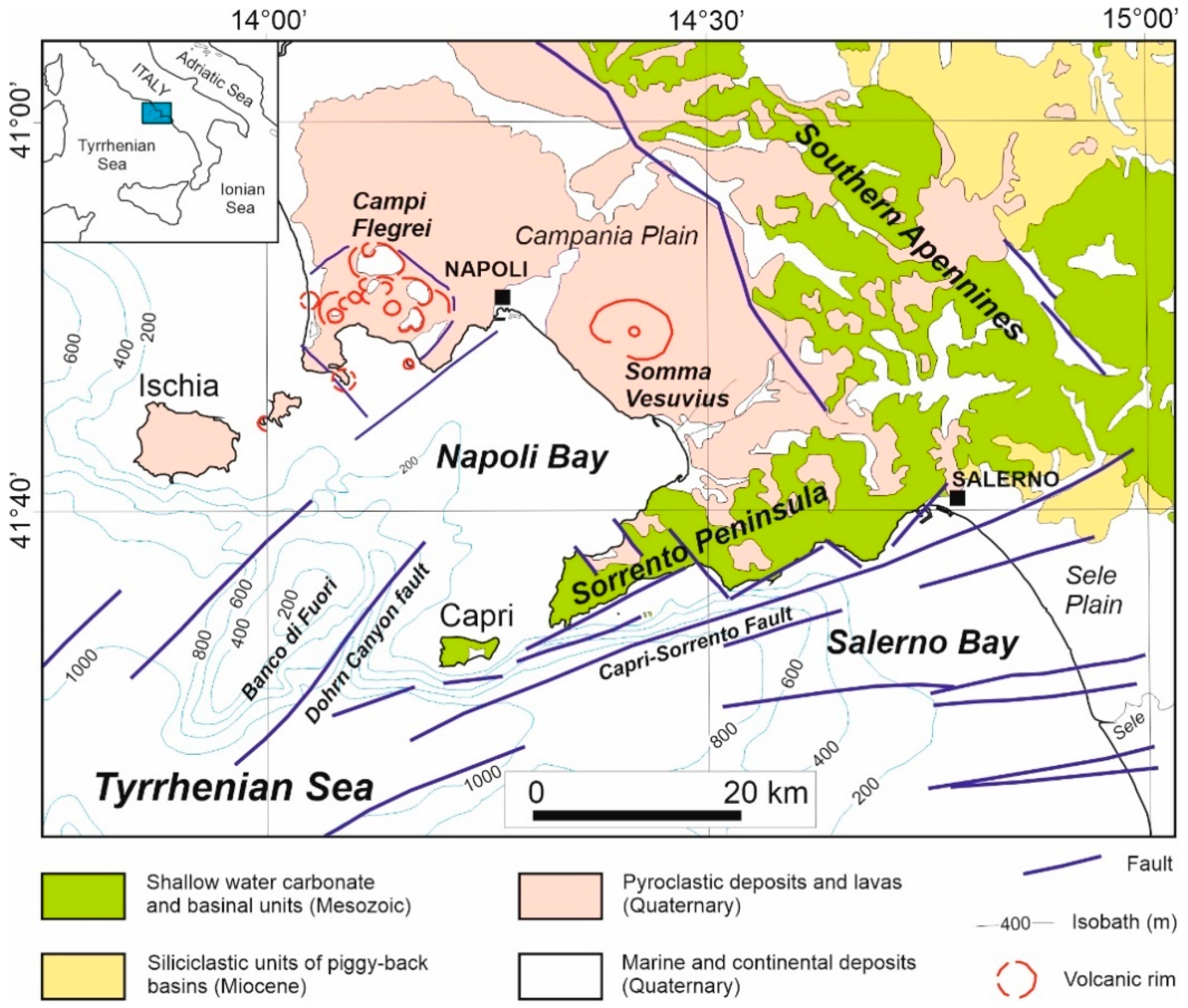
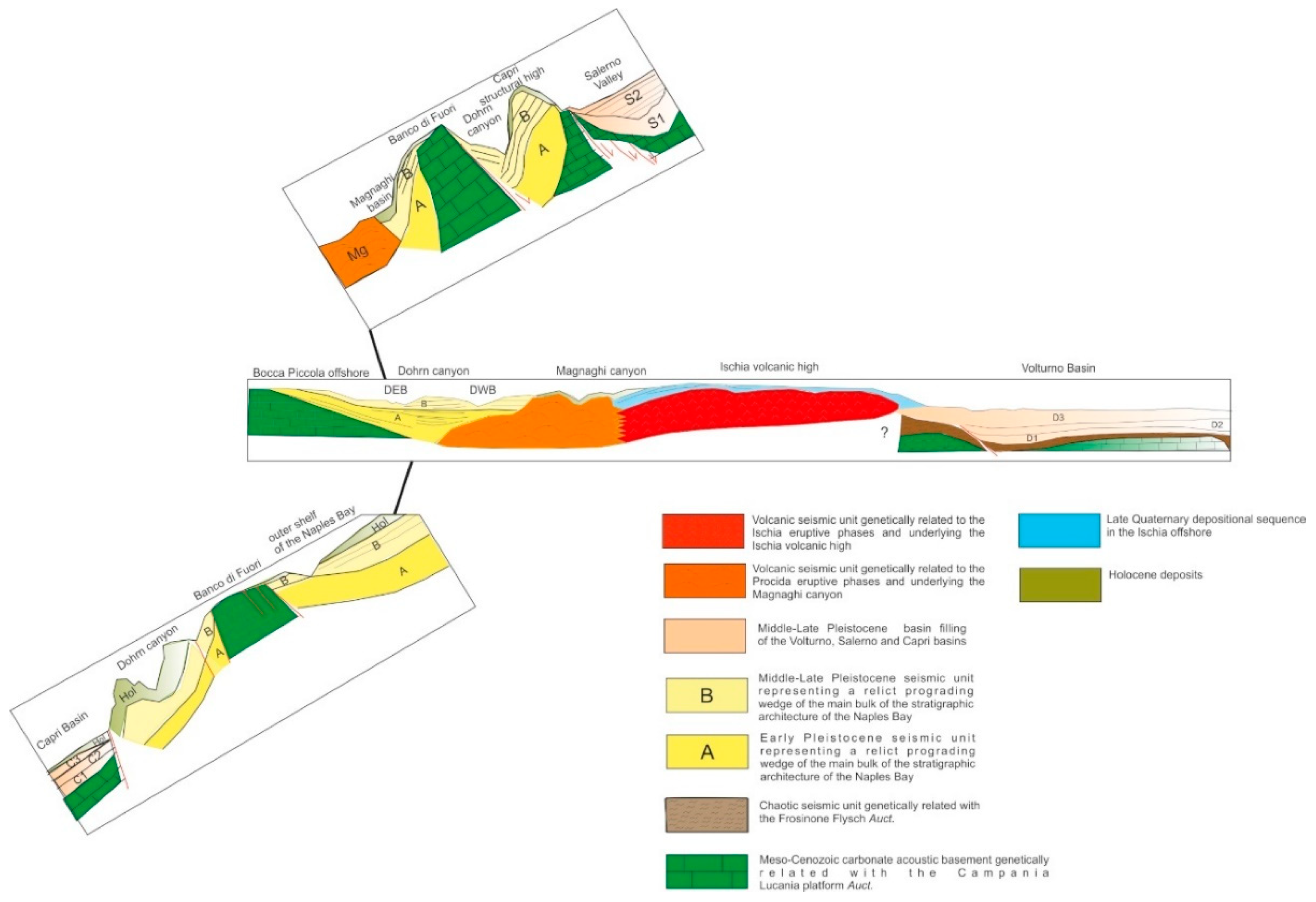
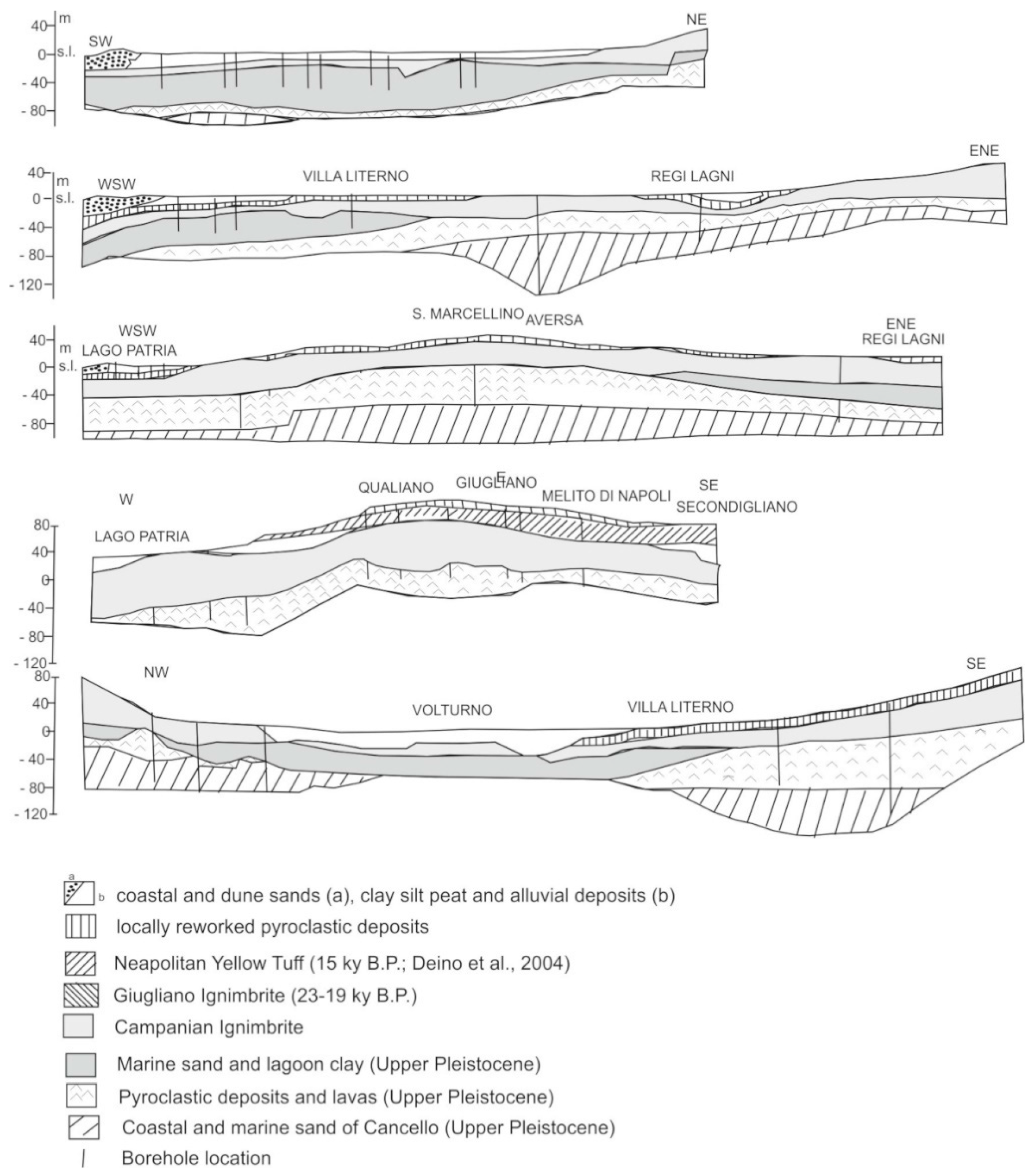

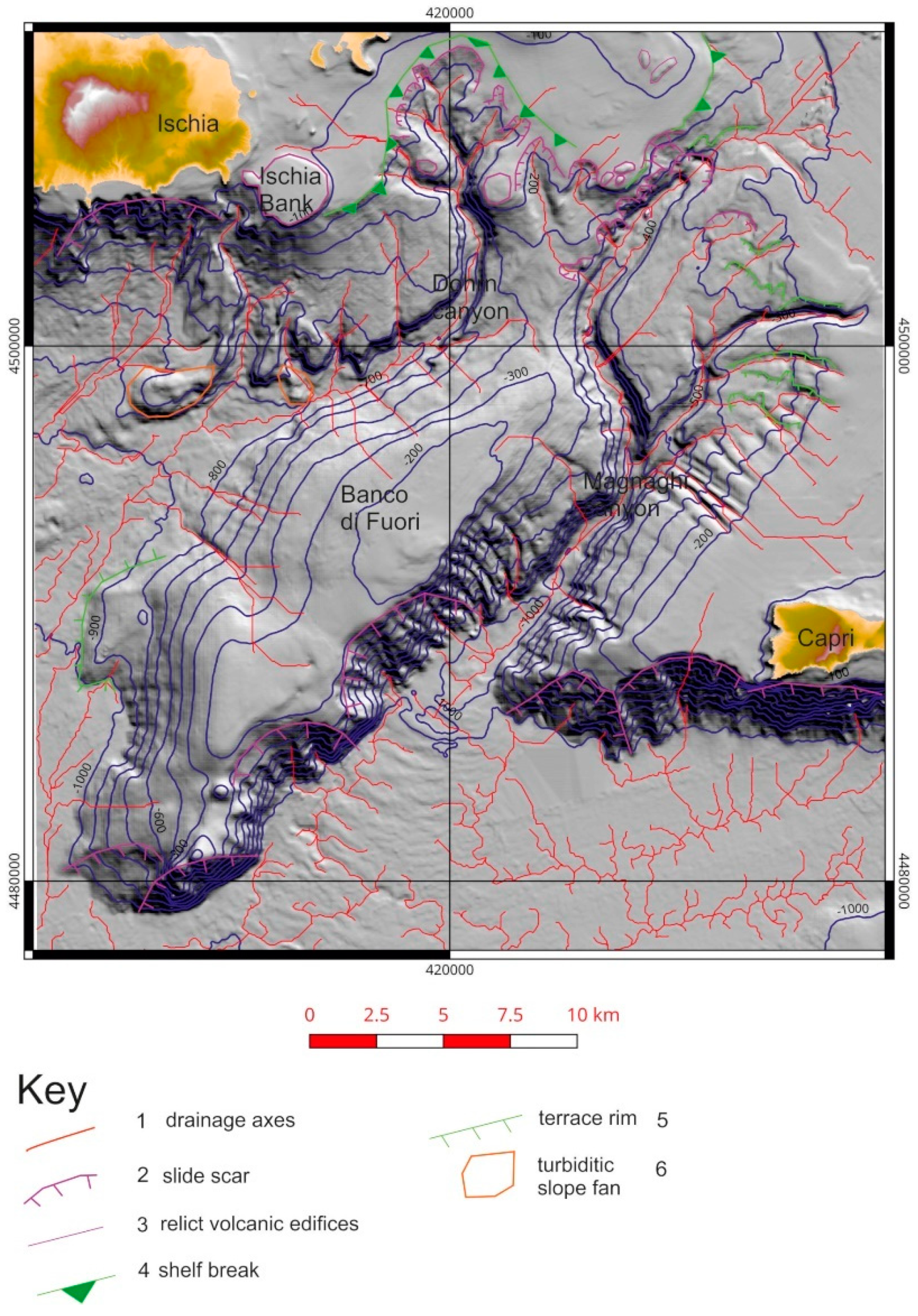
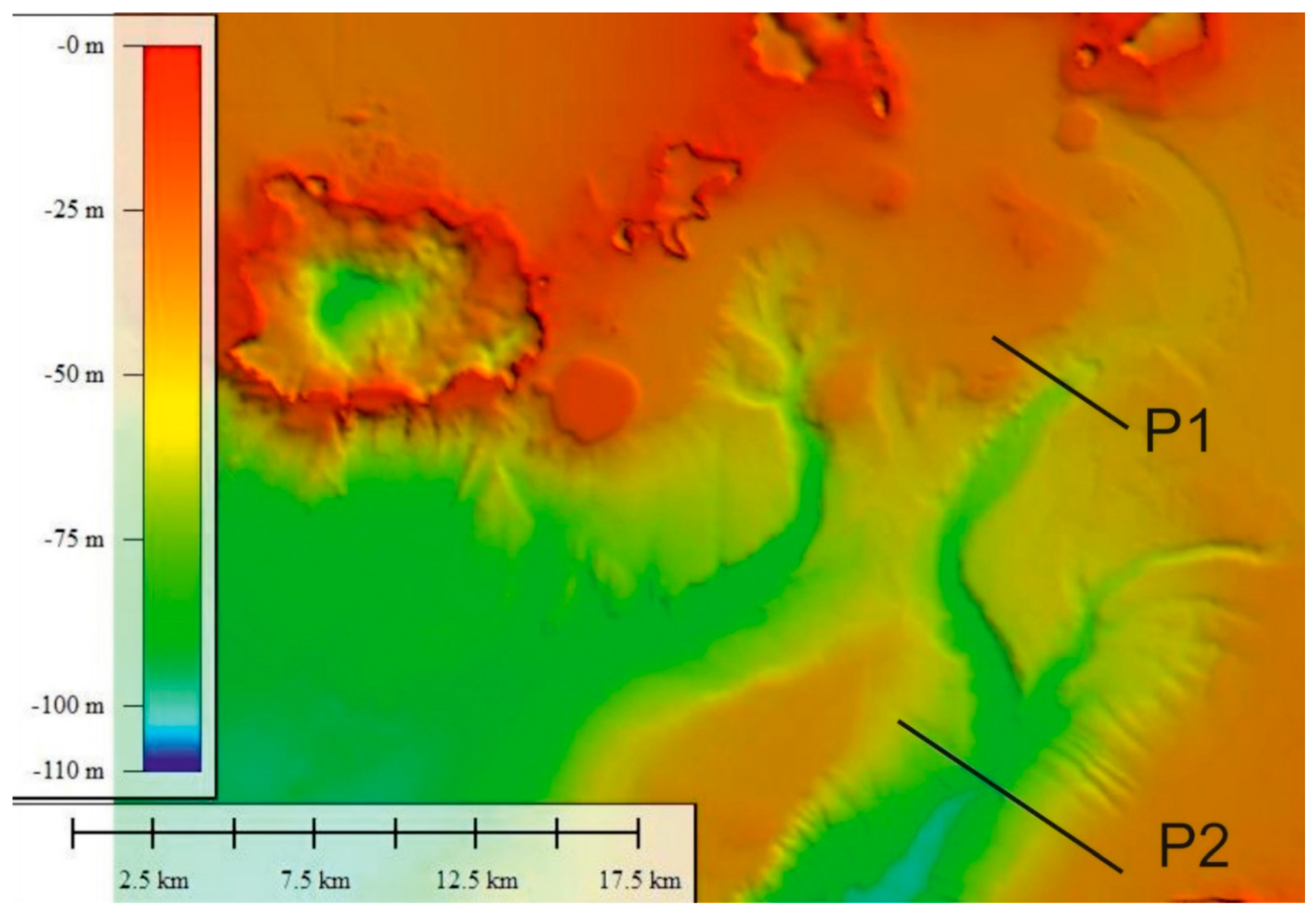
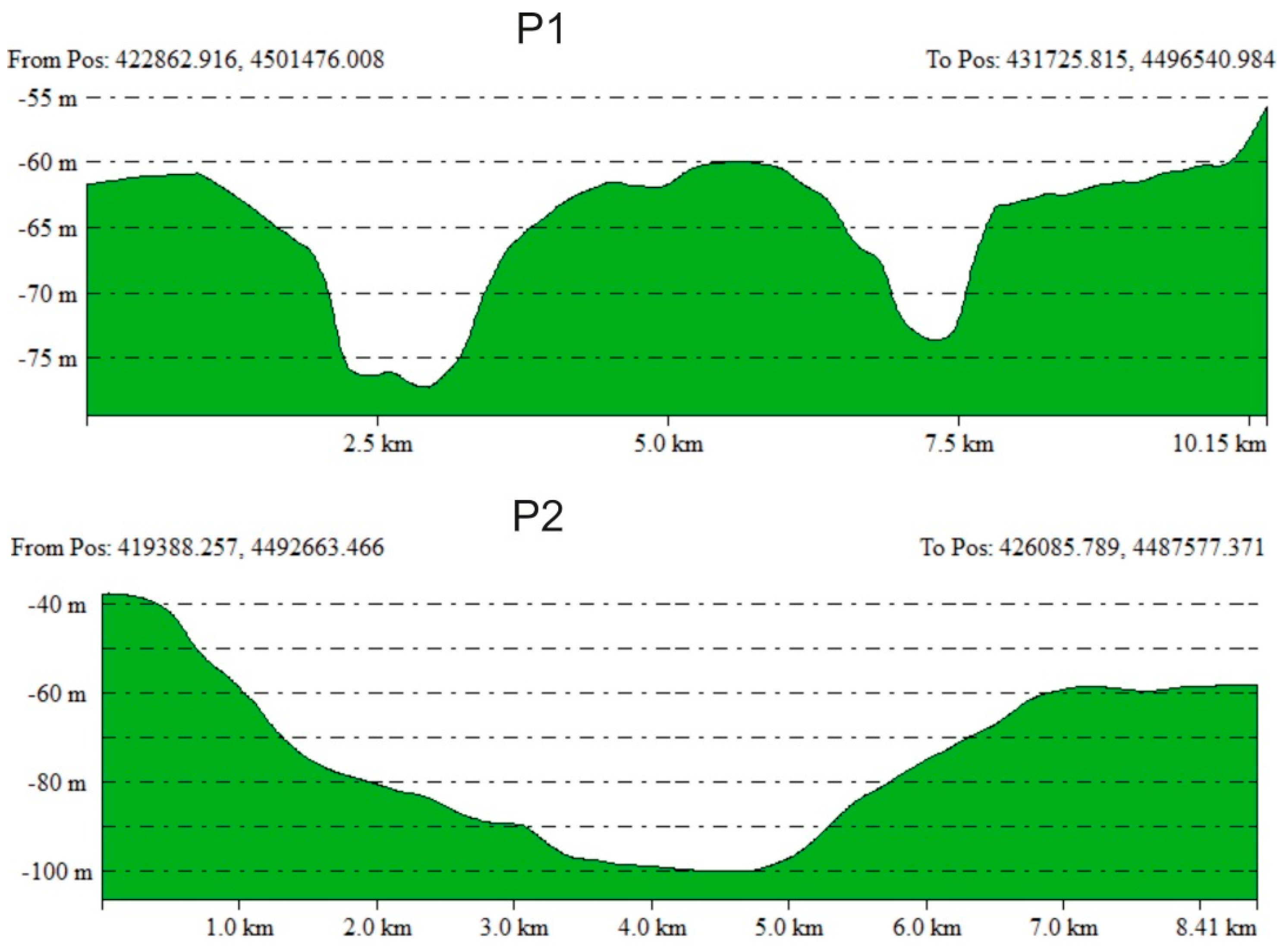
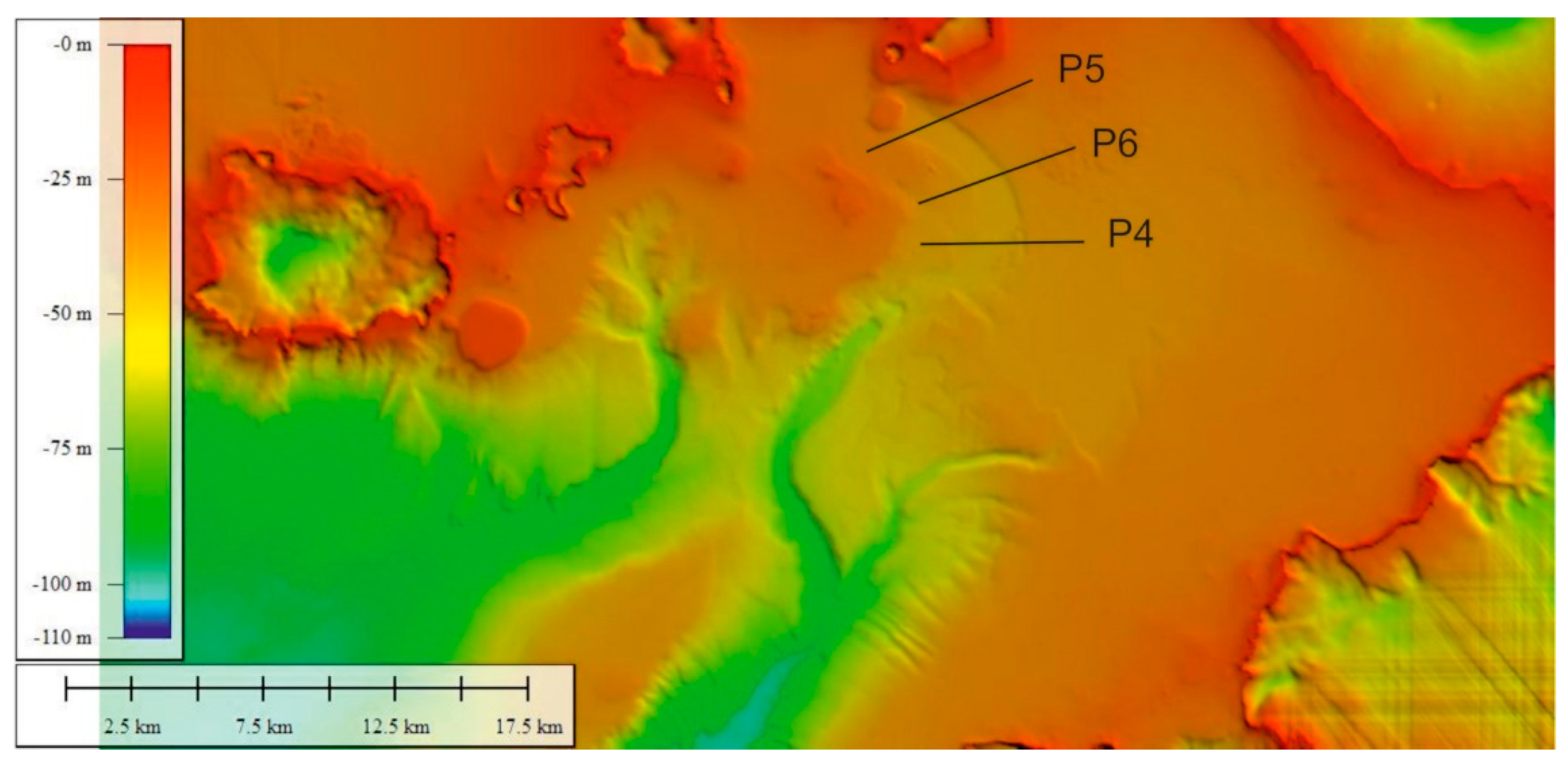

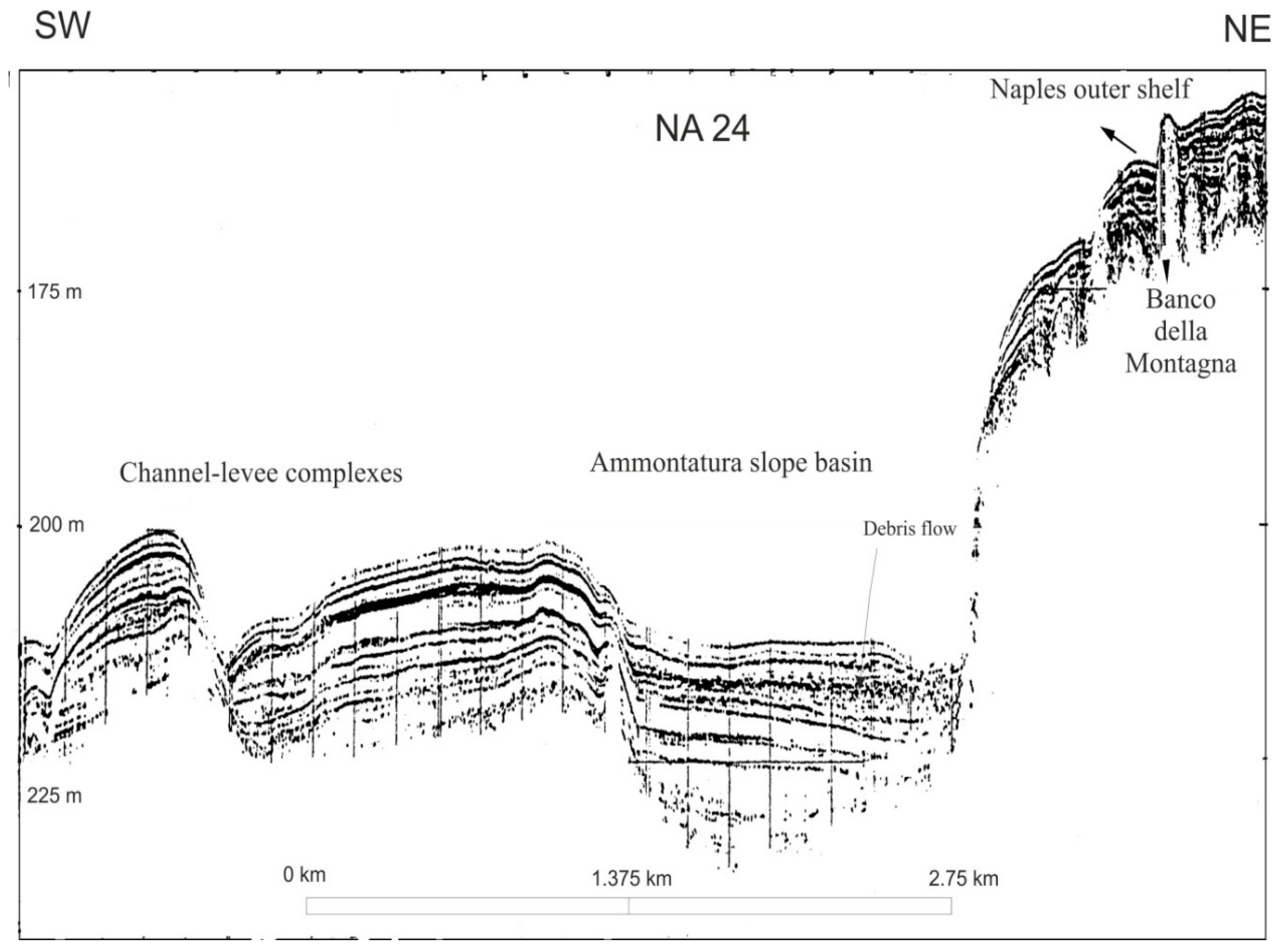
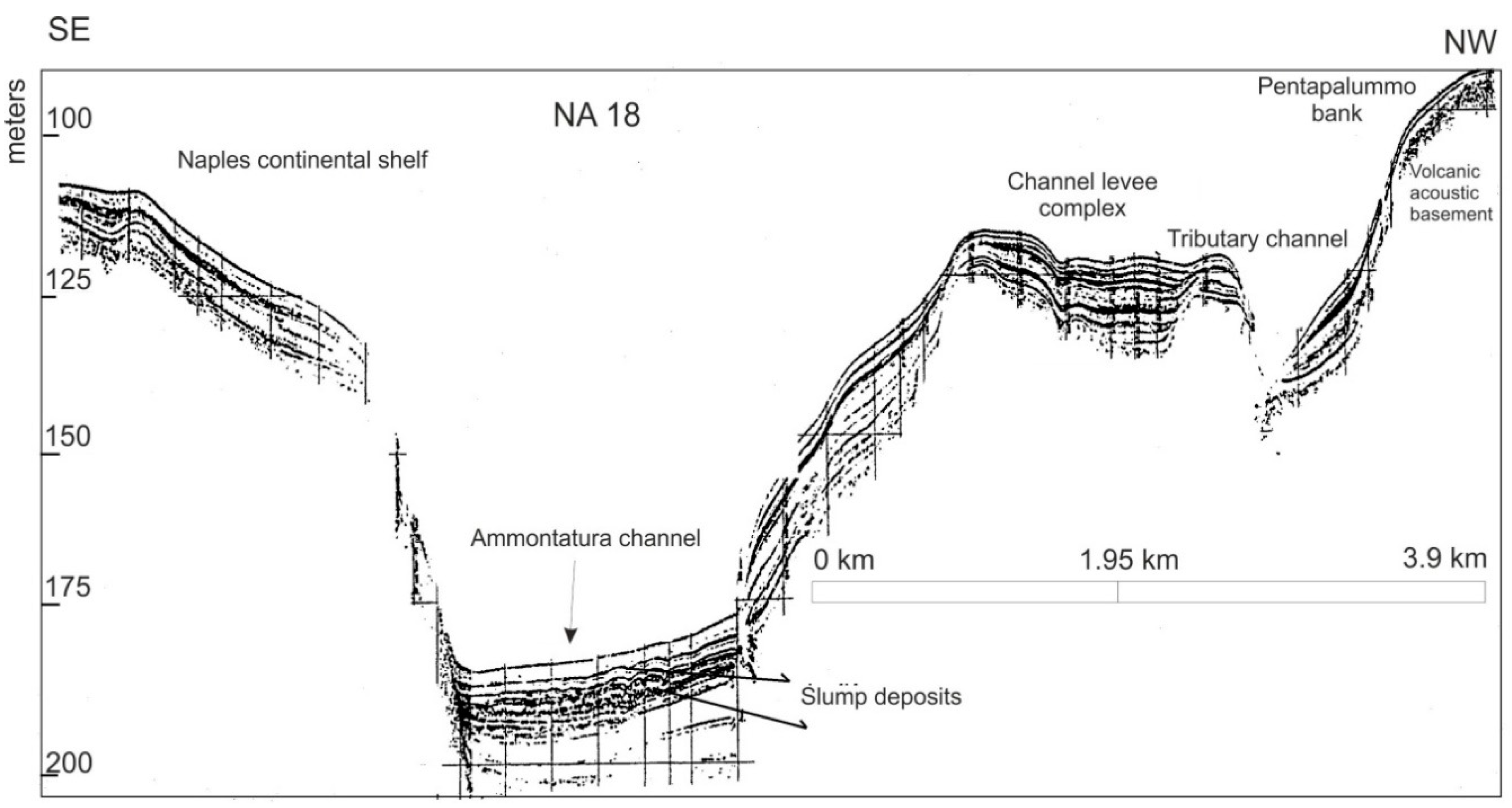
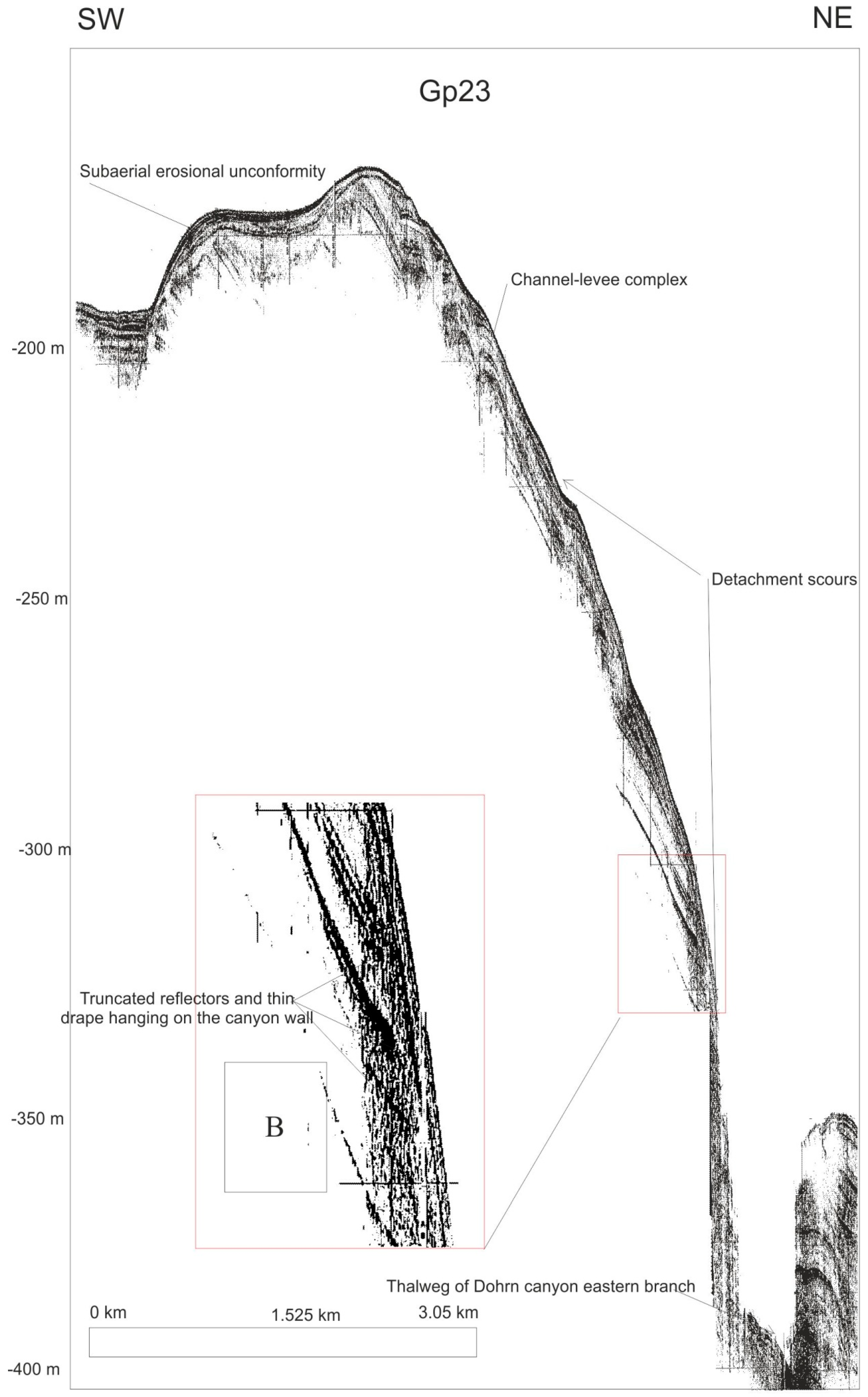
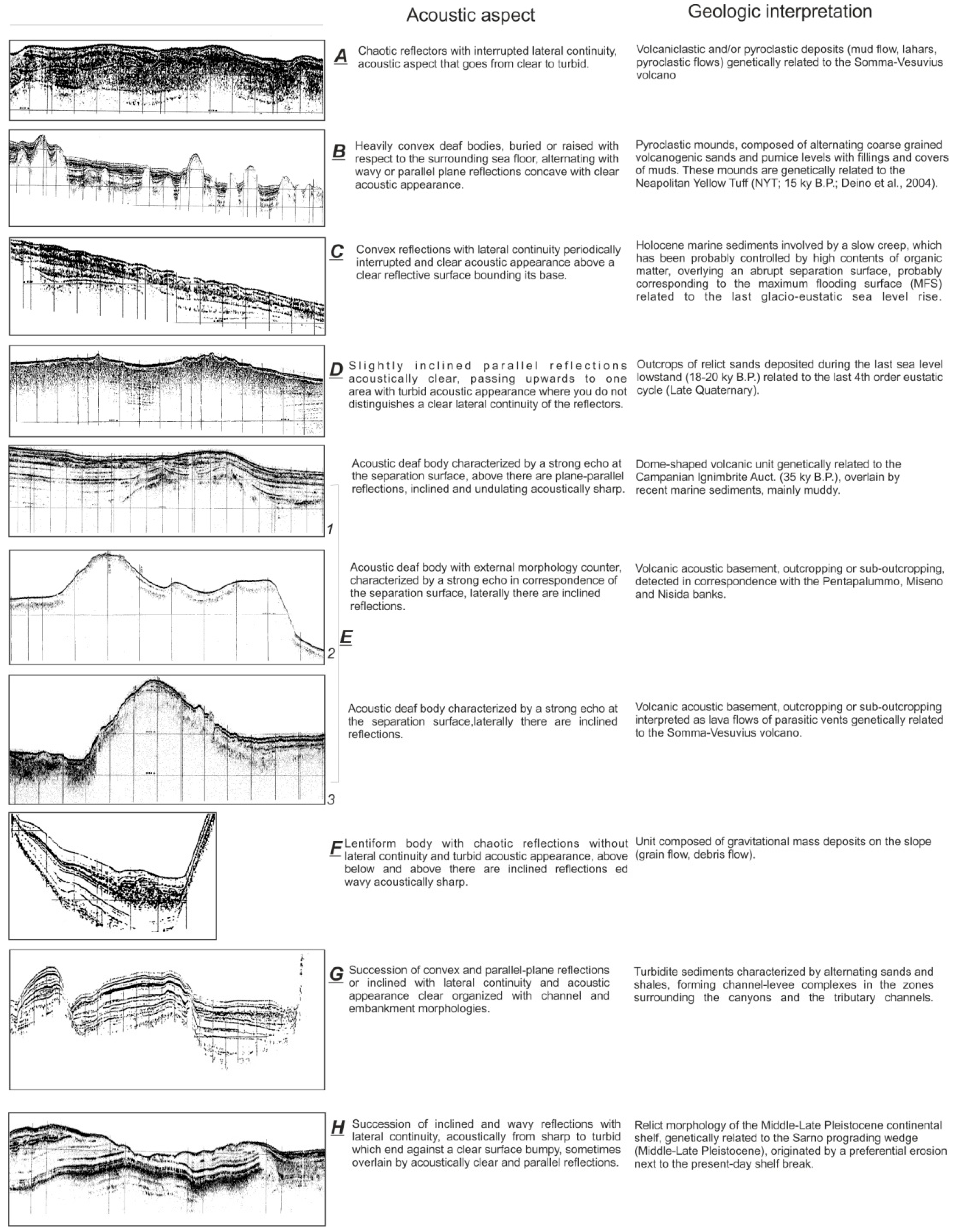
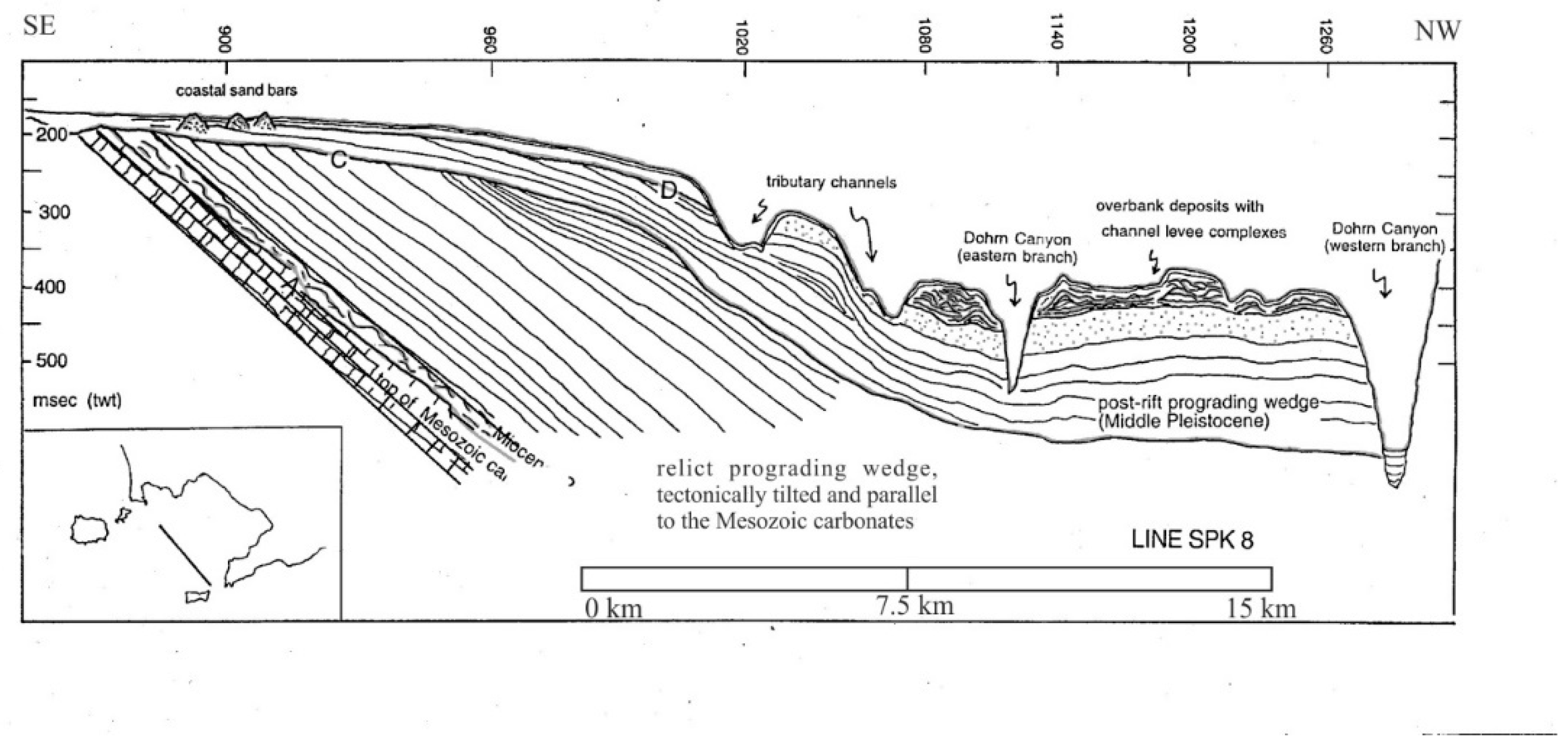
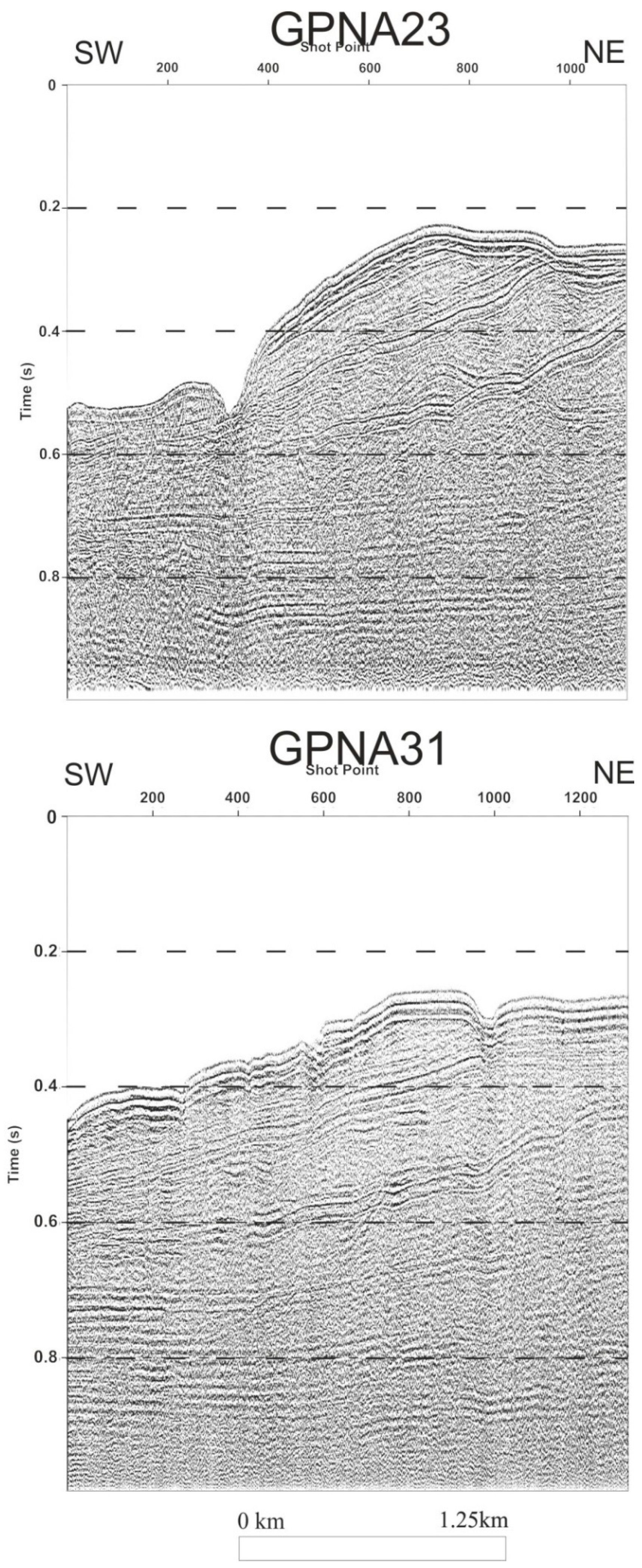
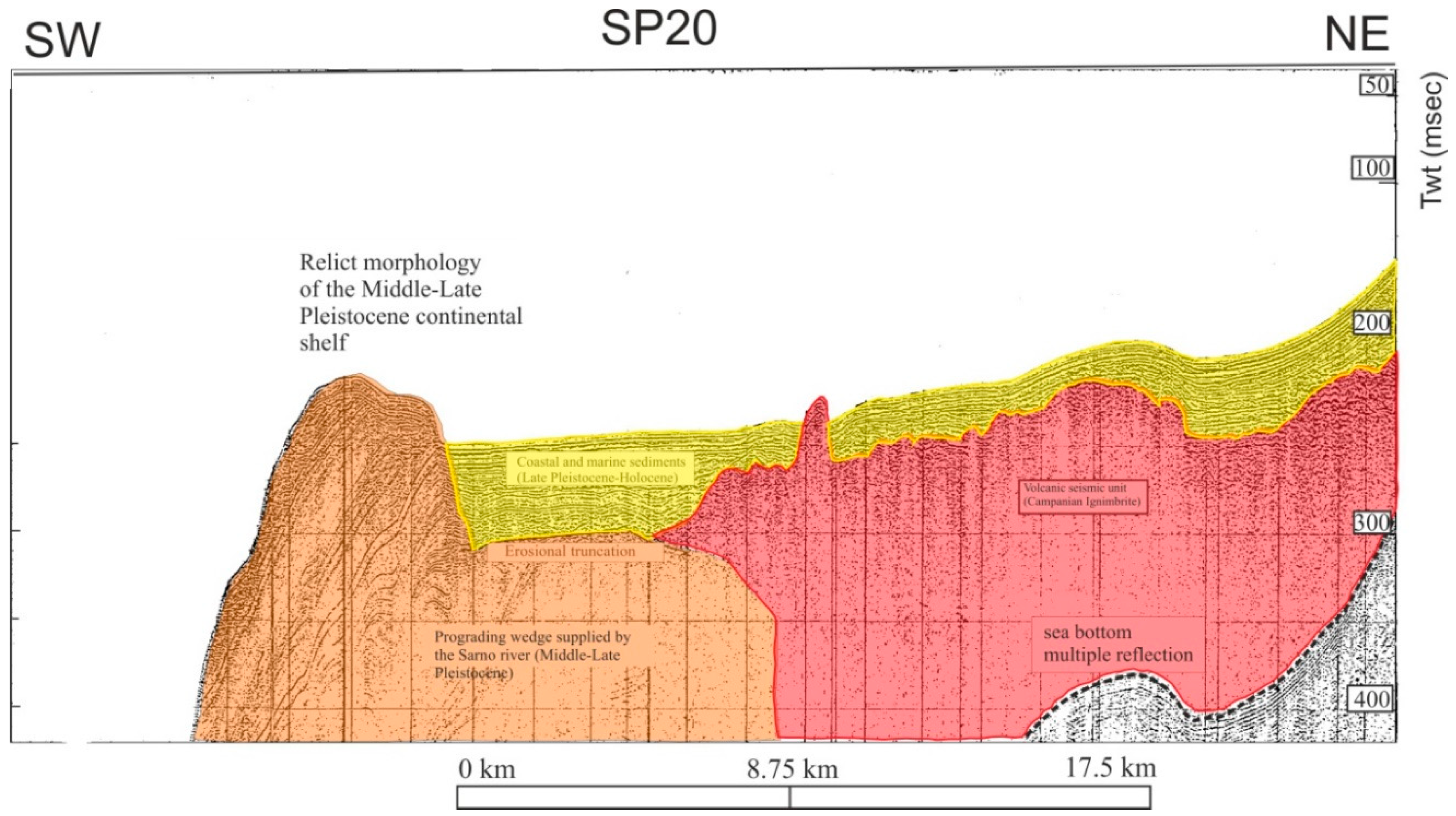
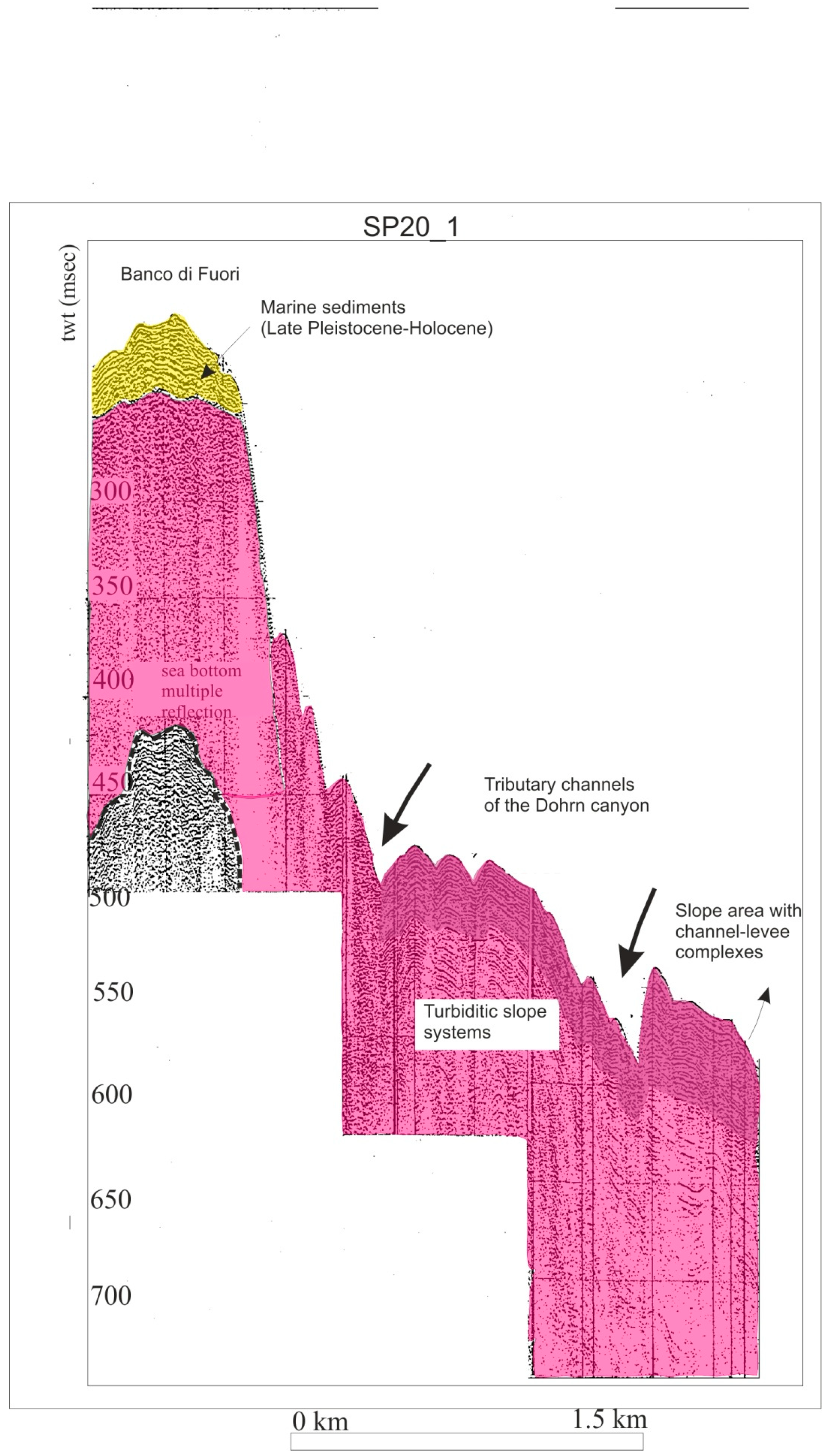
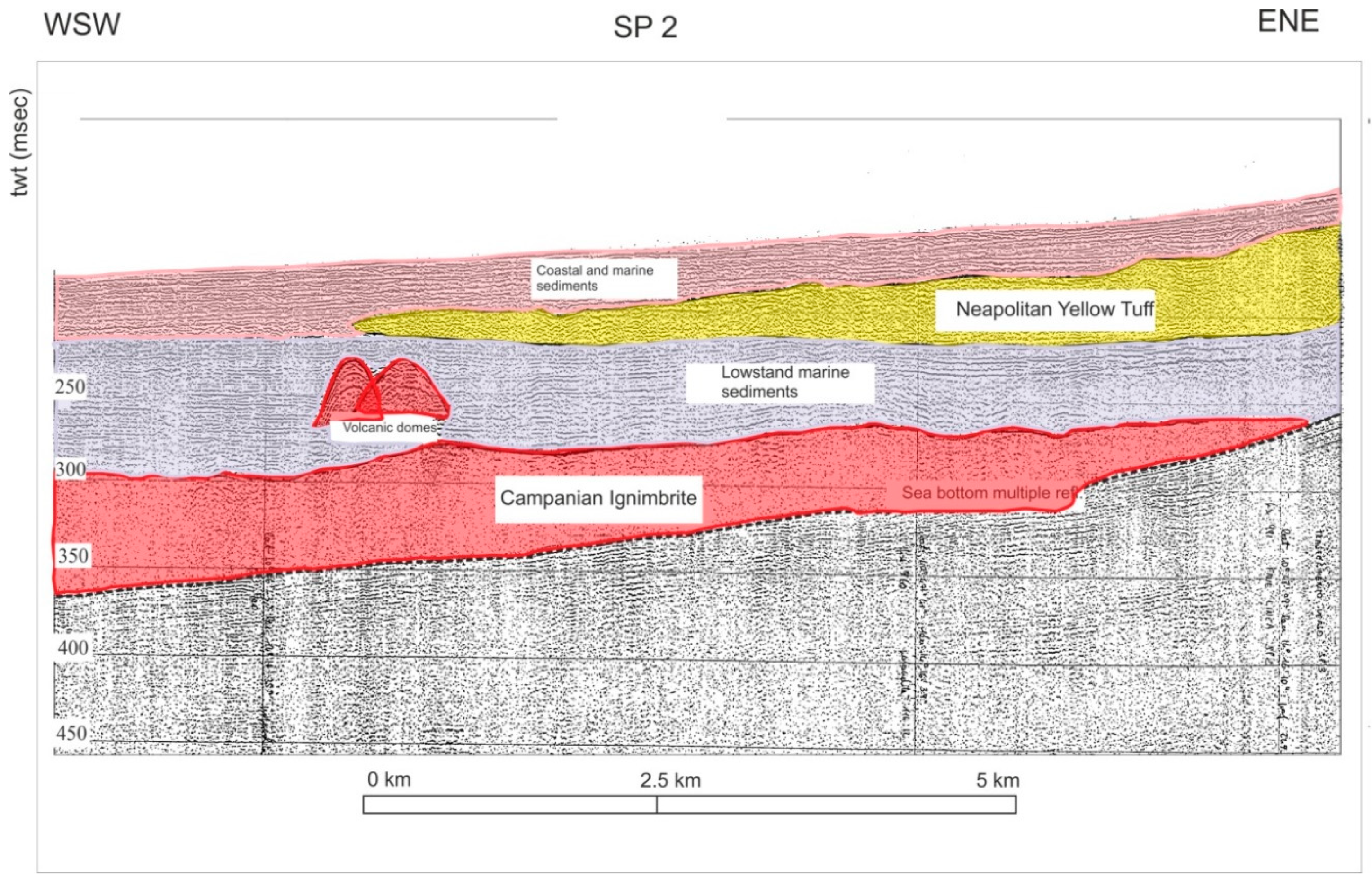
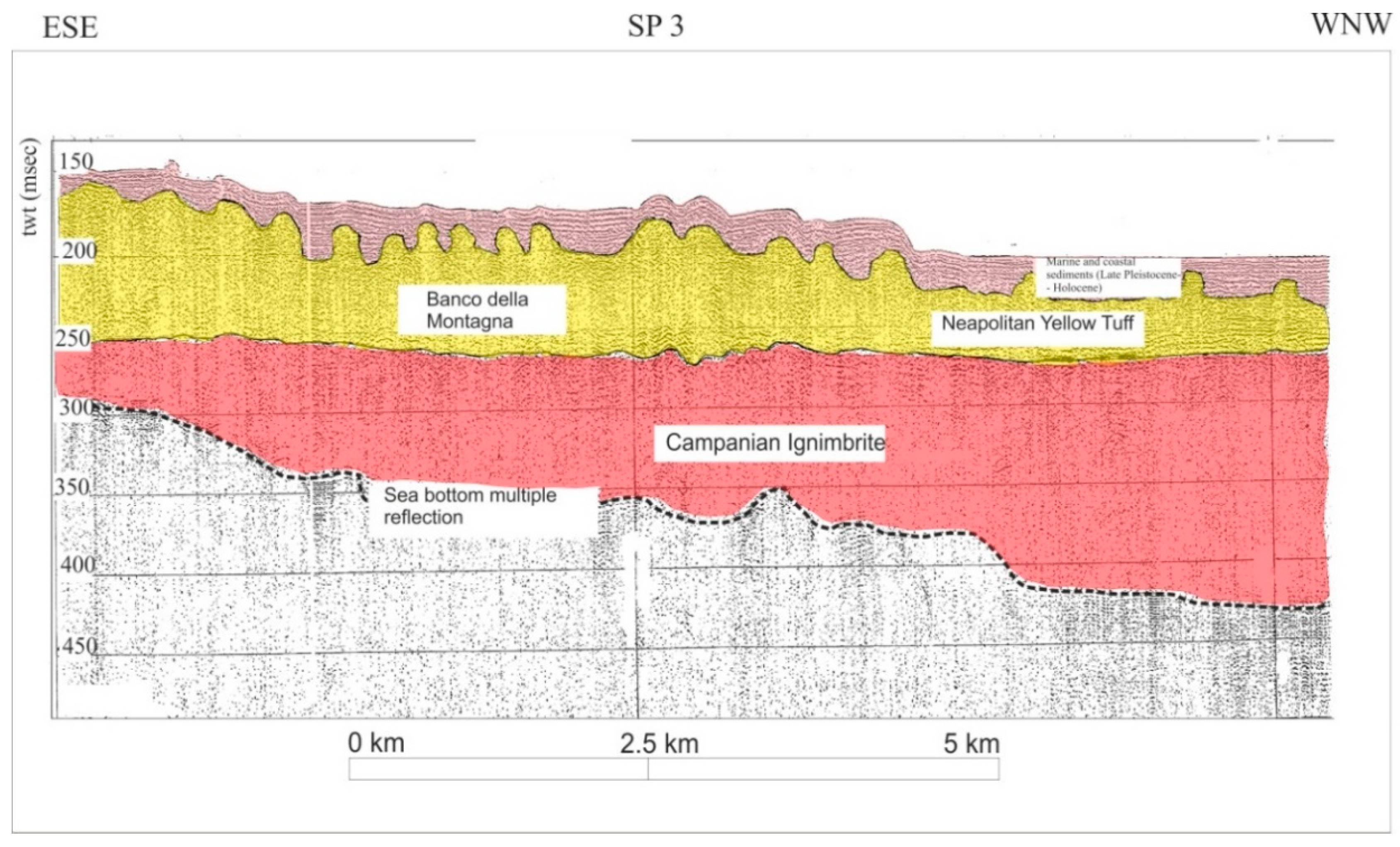
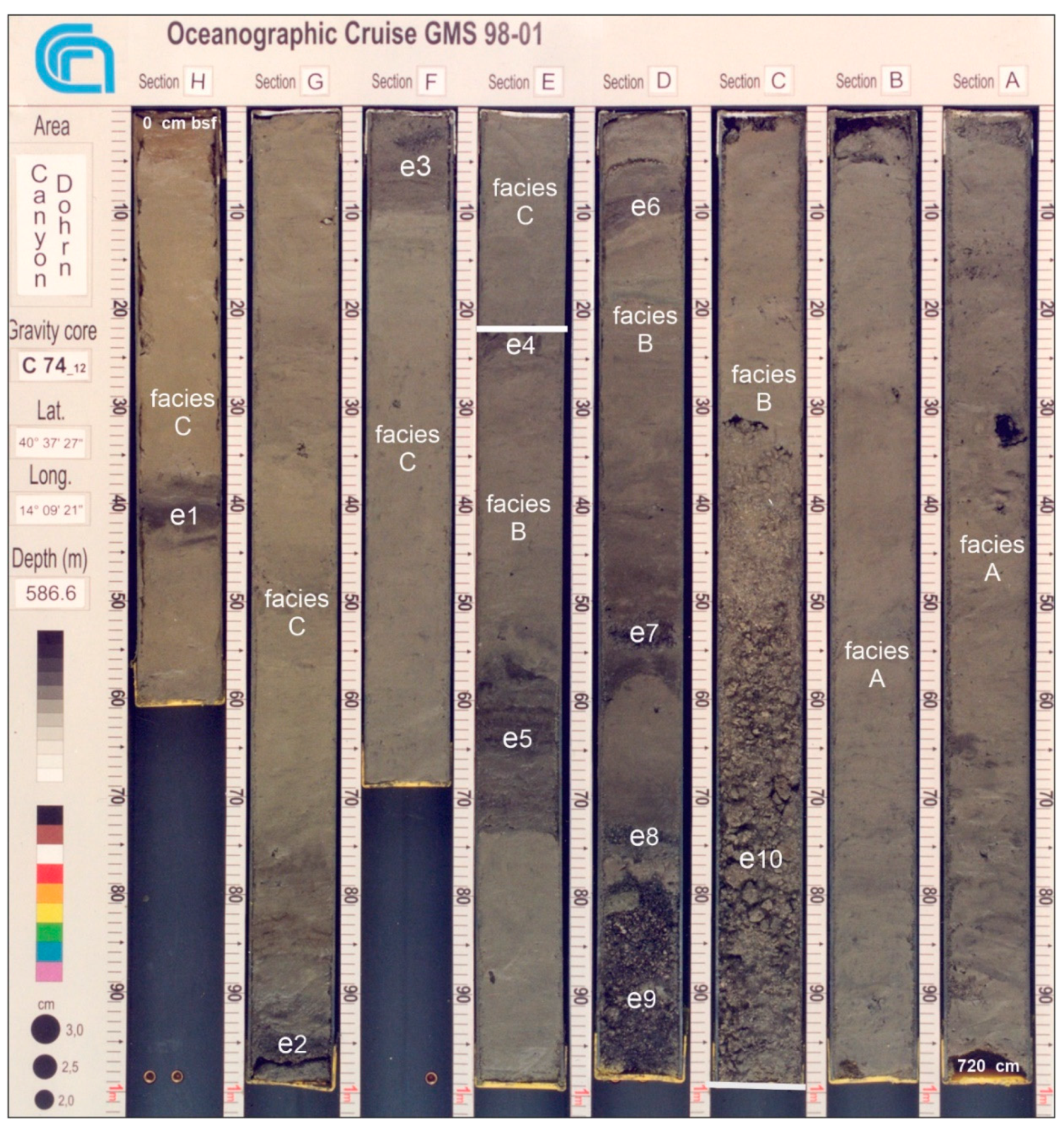

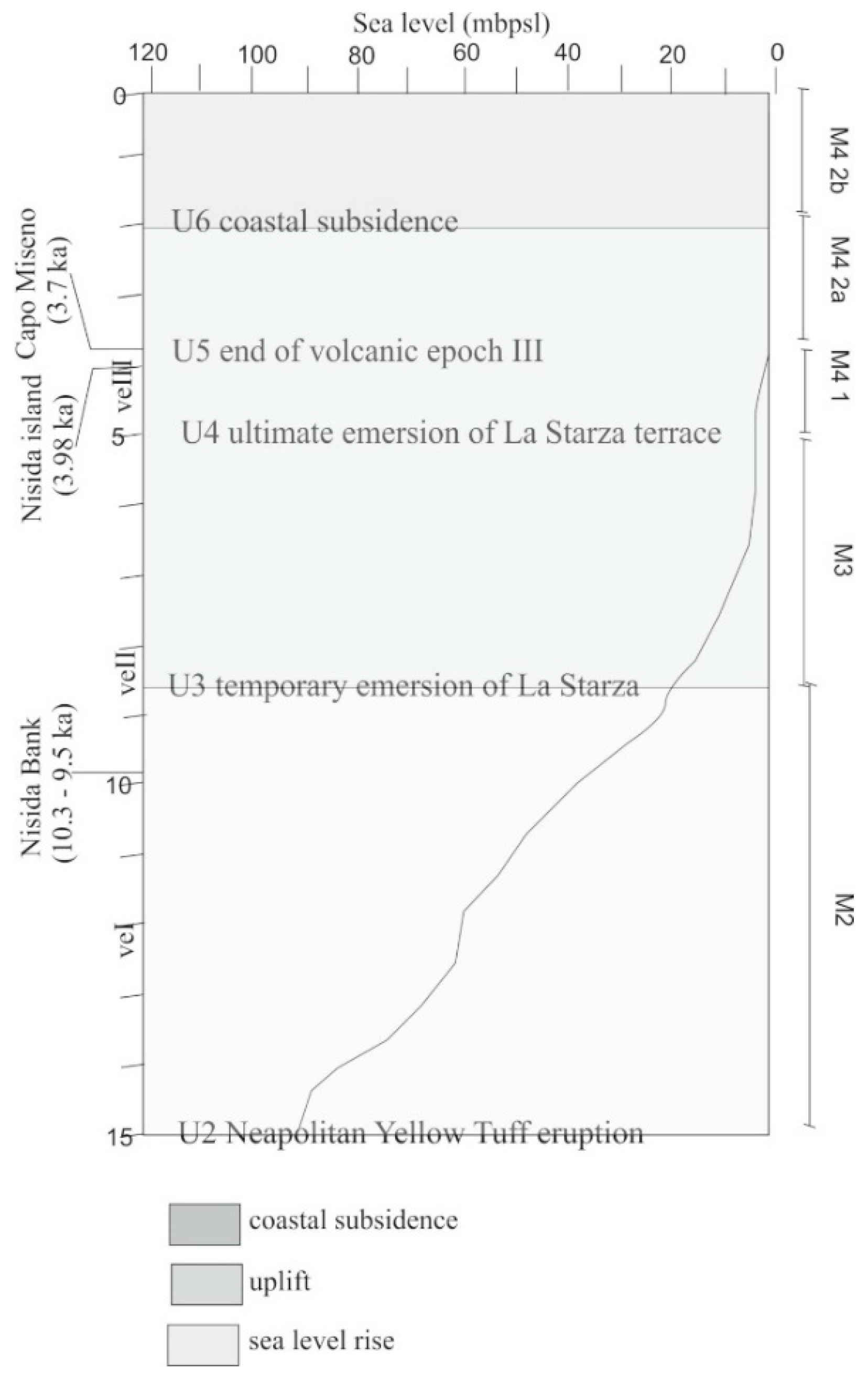
© 2020 by the authors. Licensee MDPI, Basel, Switzerland. This article is an open access article distributed under the terms and conditions of the Creative Commons Attribution (CC BY) license (http://creativecommons.org/licenses/by/4.0/).
Share and Cite
Aiello, G.; Iorio, M.; Molisso, F.; Sacchi, M. Integrated Morpho-Bathymetric, Seismic-Stratigraphic, and Sedimentological Data on the Dohrn Canyon (Naples Bay, Southern Tyrrhenian Sea): Relationships with Volcanism and Tectonics. Geosciences 2020, 10, 319. https://doi.org/10.3390/geosciences10080319
Aiello G, Iorio M, Molisso F, Sacchi M. Integrated Morpho-Bathymetric, Seismic-Stratigraphic, and Sedimentological Data on the Dohrn Canyon (Naples Bay, Southern Tyrrhenian Sea): Relationships with Volcanism and Tectonics. Geosciences. 2020; 10(8):319. https://doi.org/10.3390/geosciences10080319
Chicago/Turabian StyleAiello, Gemma, Marina Iorio, Flavia Molisso, and Marco Sacchi. 2020. "Integrated Morpho-Bathymetric, Seismic-Stratigraphic, and Sedimentological Data on the Dohrn Canyon (Naples Bay, Southern Tyrrhenian Sea): Relationships with Volcanism and Tectonics" Geosciences 10, no. 8: 319. https://doi.org/10.3390/geosciences10080319
APA StyleAiello, G., Iorio, M., Molisso, F., & Sacchi, M. (2020). Integrated Morpho-Bathymetric, Seismic-Stratigraphic, and Sedimentological Data on the Dohrn Canyon (Naples Bay, Southern Tyrrhenian Sea): Relationships with Volcanism and Tectonics. Geosciences, 10(8), 319. https://doi.org/10.3390/geosciences10080319





